You want to grow your business – and need email marketing software that’s easy to use, affordable, and will turn your leads into customers – right?
It sounds simple enough, but with an overwhelming 450+ email marketing tools to choose from – and with every email marketing company’s website saying the same thing, it’s anything but simple.
To identify the best email marketing software for different businesses, we surveyed 1,700+ marketers – ranging from single-person startups to Fortune 500 CMOs – who were in the process of changing email marketing software to understand which tool they’re moving from and to – and why.
The following top 10 list is the result of hundreds of hours of research, that I hope will assist you in choosing the perfect email marketing software for you.
The 10 Best Email Marketing Software
- ActiveCampaign – best for small businesses & enterprise
- Benchmark – best for agencies
- Sendinblue – best for transactional emails
- Drip – best for small-medium e-commerce businesses
- Omnisend – best for medium-large e-commerce businesses
- Autopilot – best for marketing automation
- HubSpot – best for B2B service companies
- MailerLite – best for personal projects
- ConvertKit – best for bloggers
- EmailOctopus – best for developers (uses AWS)
Below, we’ve outlined a candid review of each tool’s pros and cons. We then break down the factors that define great email marketing software, with a head-to-head comparison of all ten email marketing tools across all nine factors; from affordability and ease of use to integrations and deliverability.
Additional information
- What should you look for in email marketing software?
- Best ease of use
- Best for deliverability
- Best for email marketing features
- Best for CRM & marketing automation features
- Best for reporting & analytics
- Best for integrations
- Best for security & compliance
UP she go's again ▲
#1 ActiveCampaign ♥
Once an underdog, ActiveCampaign is now one of the most popular email marketing tools with over 130,000 small businesses customers.
ActiveCampaign offers a collection of customer experience automation (CXA) tools – from SMS & email marketing to site messaging and CRM functionality.
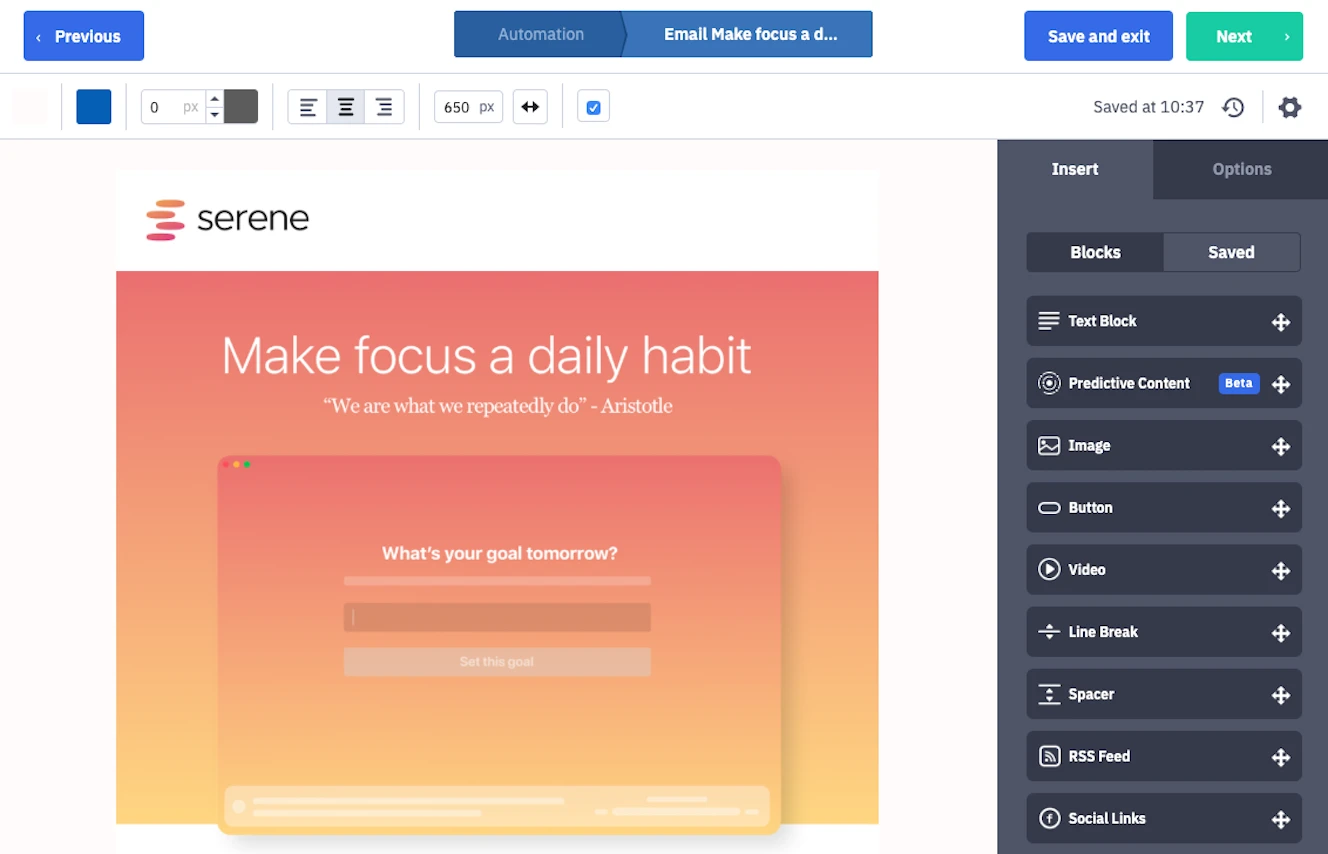
ActiveCampaign’s intuitive drag-and-drop email marketing designer
At the heart of ActiveCampaign’s platform is the automation builder; A visual canvas for building automated marketing sequences across channels.
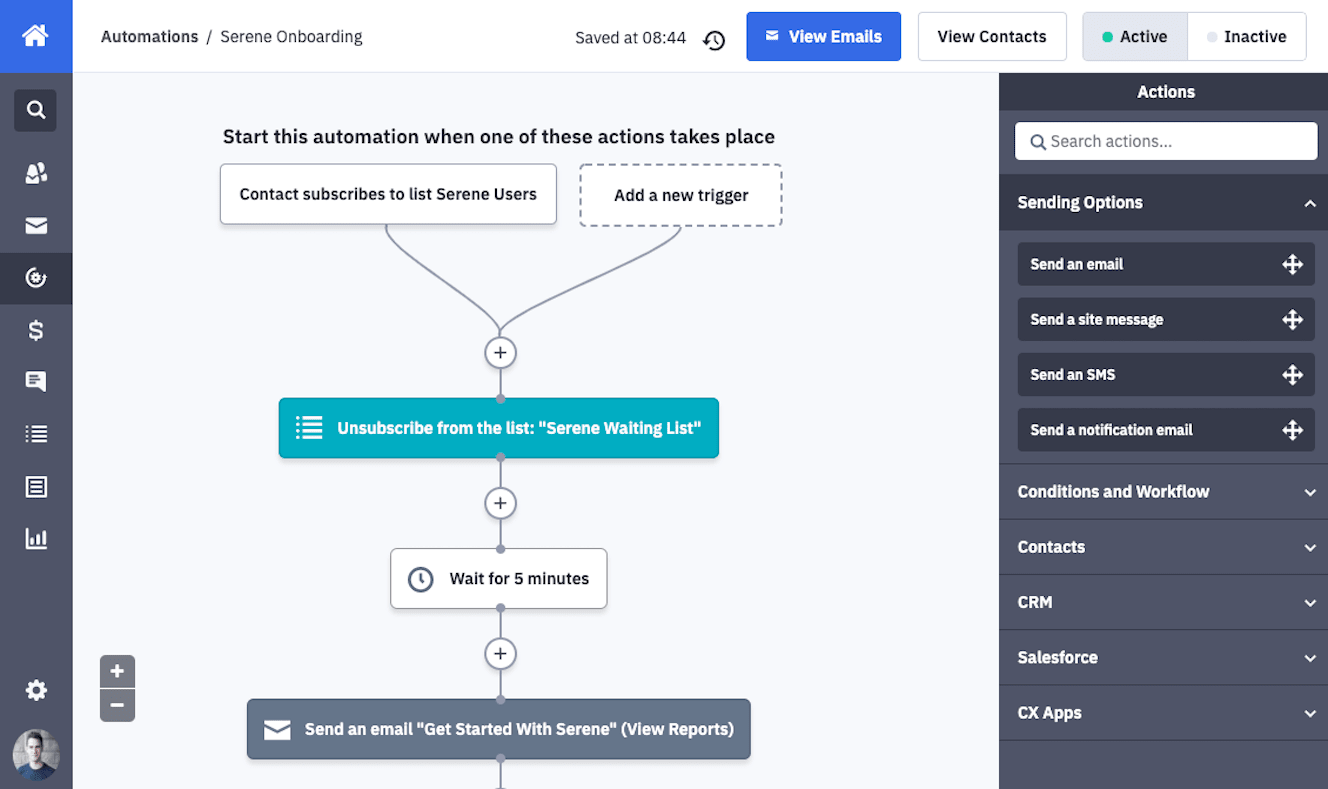
ActiveCampaign’s automation builder makes building automations easy, similar to reading a flowchart
Unlike some tools that require expensive consultants and training to use, ActiveCampaign’s intuitive design enables anyone to craft powerful email automation sequences from scratch or by importing one of their 500+ automation recipes.
While email A/B testing is offered by most tools in the top 10, ActiveCampaign goes one step further by allowing you to run A/B split tests of entire automation sequences. This means you can test anything – from the number of touchpoints to the delays between emails and beyond. All of this ensures that your marketing improves with time – on autopilot.
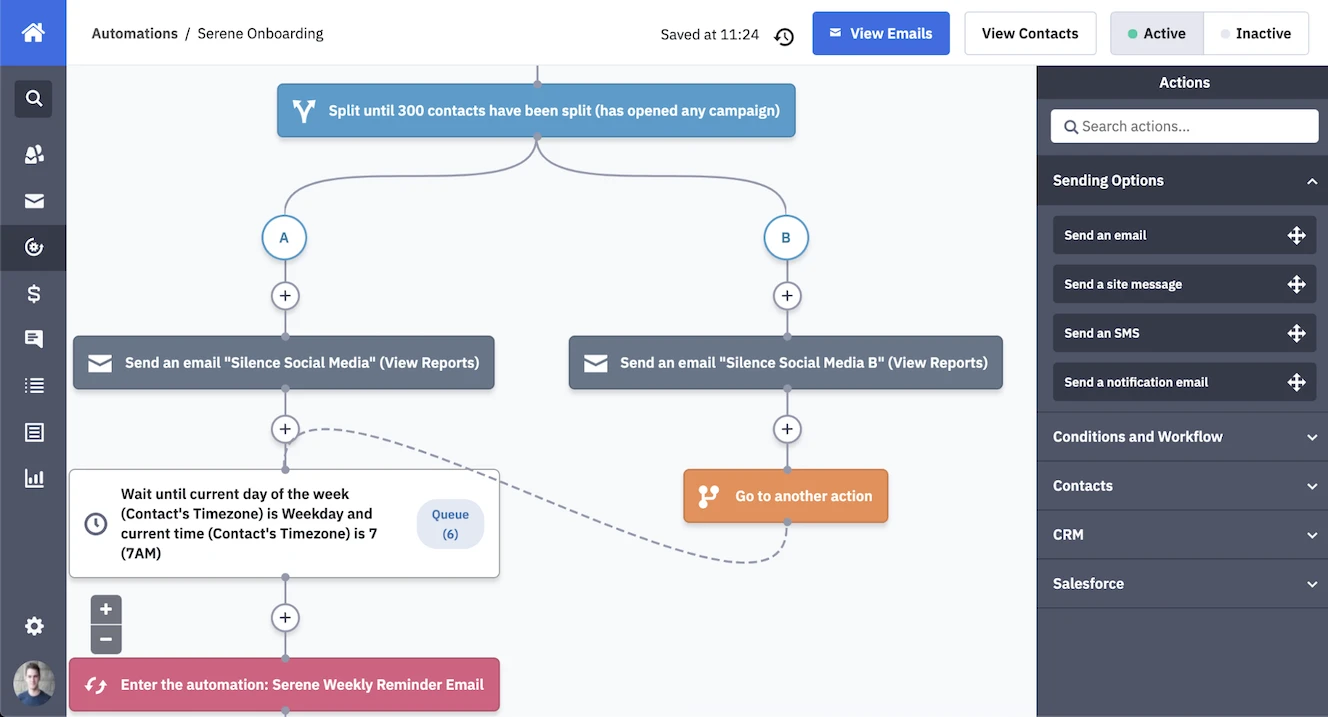
Advanced automation capabilities like split actions and A/B testing make it easier to optimize your performance
As an all-in-one sales and marketing tool for small businesses, ActiveCampaign comes with an in-built CRM system to manage yours sales, live chat, and of course email marketing automation in one place.
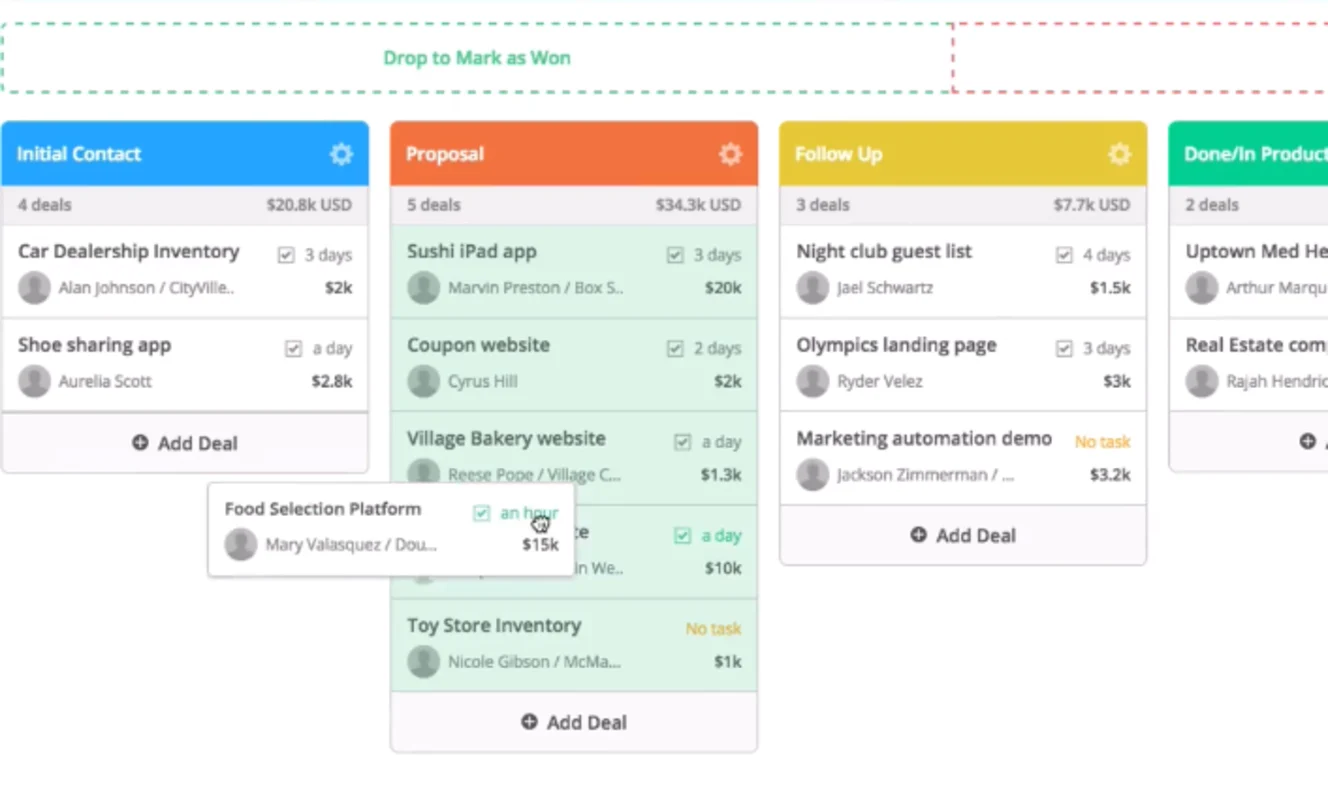
A built-in sales CRM makes it easier to manage deals, but also connects to ActiveCampaign’s powerful automation engine
And, incredibly, they’ve done all of this with a price tag that’s 1/10th of many email marketing tools featured in this guide – starting at $9/month.
Our survey respondents using ActiveCampaign were overwhelmingly positive about it – and it was one of the most likely tools that businesses of all sizes were likely to move to.
What are ActiveCampaign’s Key Features?
→ 125+ Email templates
→ 500+ Automation recipes
→ 800+ Integrations
→ Landing pages
→ SMS messaging
→ Custom reporting
→ Web personalisation
→ CRM
→ Split actions and A/B Testing
→ Predictive content
→ Predictive sending
→ Goal tracking and attribution
For the vast majority of small businesses looking for a great email marketing tool that’s easy to use and affordable, ActiveCampaign is likely the best balance of power, affordability and ease of use.
Apply for an ActiveCampaign demo account at our preferred certified agency in The Netherlands
UP she go's again ▲
#2 Benchmark
Benchmark is an interesting option for any business looking for a well-designed and easy-to-use email marketing tool.
While not quite as well known as other tools in the top ten, they’ve become an increasingly popular response to “Which tool are you moving to?” in our survey.
Benchmark do everything pretty well and are reasonably priced, but there’s one thing that really sets them apart from other email marketing tools – and that’s design.
Everything from their templates to the platform itself is beautifully-designed – and not just visually attractive, but great user experience. While that may seem trivial to some, it makes all the difference when it comes to understanding your data and creating the right impression with contacts.
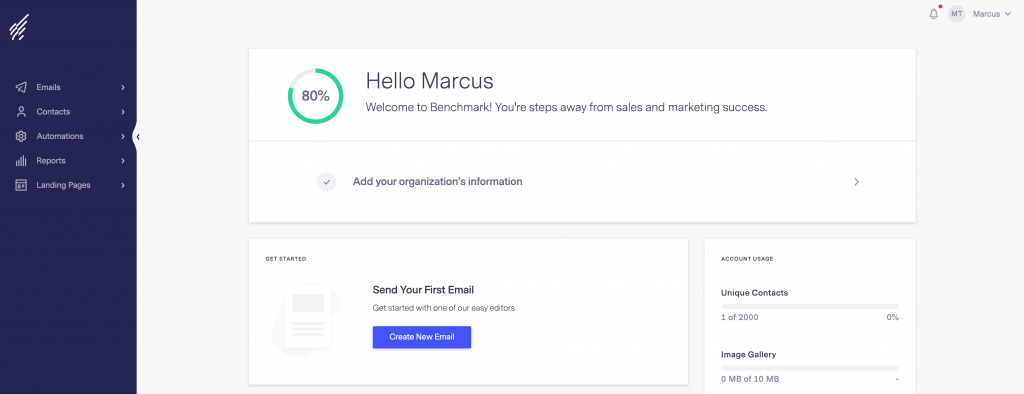
Benchmark is a good choice for any small business that needs simple, easy-to-use email marketing and automation software. It’s likely to be a particularly good choice for small agencies and consultancies where design is important both from a staff training perspective – and also providing a good experience for clients.
What are Benchmark’s key features?
→ Visual email builder
→ Marketing automation
→ 1,500+ Integrations
→ Landing pages
→ Surveys and Polls
→ Reporting
→ Sign-up forms
→ A/B Testing
UP she go's again ▲
#3 Sendinblue
Sendinblue is best-known as one of the leading transactional email services. Building on this reputation they built an email marketing automation product.
We use Sendinblue to send transactional emails for two of our ventures (Leadformly and Serene), as they’re one of the few email marketing providers with servers in the European Union (which helps with our GDPR compliance) and they have good deliverability rates (we’re currently at 98%).
While I can’t comment on their marketing automation features from first-hand experience, it’s evident from our customer surveys that it’s good, but lacks some of the more advanced features (such as goal tracking, native integrations, and annotations).
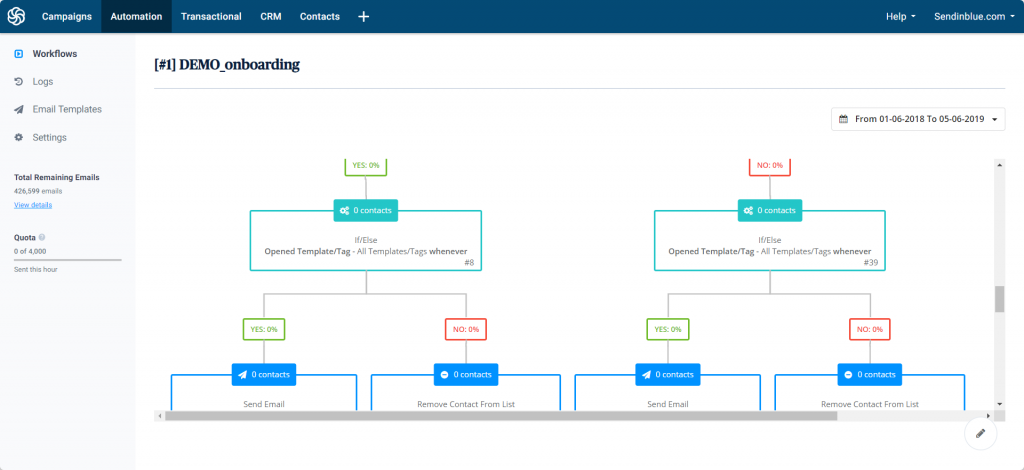
If you need an email marketing tool with a solid API to get your emails into inboxes with a good deliverability rate, Sendinblue’s pre-built developer recipes make it an excellent choice.
What are Sendinblue’s key features?
→ Marketing automation
→ SMS
→ Live chat
→ CRM
→ Transactional email
→ Landing pages
→ Sign-up forms
→ Facebook Ads
UP she go's again ▲
#4 Drip
I think it’s fair to say that Drip’s focus is on smaller to medium-sized e-commerce businesses, whereas our next email marketing tool (Omnisend) seems better suited to the larger e-commerce stores.
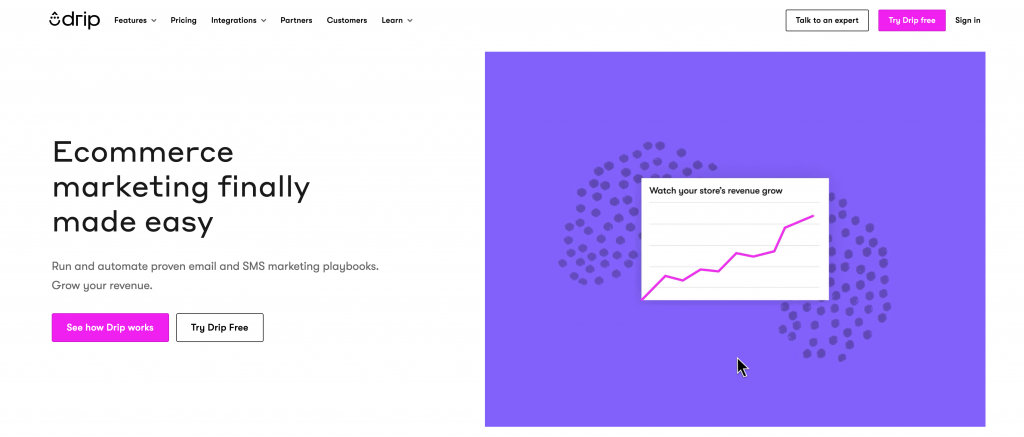
As you’d expect, Drip integrates deeply with all mainstream e-commerce platforms like Shopify, Magento and WooCommerce – as well as the more obscure and custom-made ones.
With built-in revenue analytics and tools to engage customers across multiple channels (from social channels to SMS) Drip is ideally positioned as a powerful tool for growing e-commerce stores.
Their pricing is also palatable, starting at $19/month for small list sizes.
What are Drip’s key features?
→ Visual automation
→ Email and SMS marketing
→ Dynamic e-commerce content blocks
→ Discount codes
→ e-commerce Segmentation
→ Retargeting
→ e-commerce store integrations
→ Reporting dashboards
→ Split testing sequences
UP she go's again ▲
#5 Omnisend
Omnisend is quickly becoming one of the leading marketing platforms for e-commerce stores.
Designed to help e-commerce brands control their marketing across multiple channels, Omnisend offers automated email, SMS, push notifications, and most impressively, integrations with Google Ads, Instagram, Facebook Ads, Messenger, and WhatsApp – which they claim have 10X higher click-through rates than email.
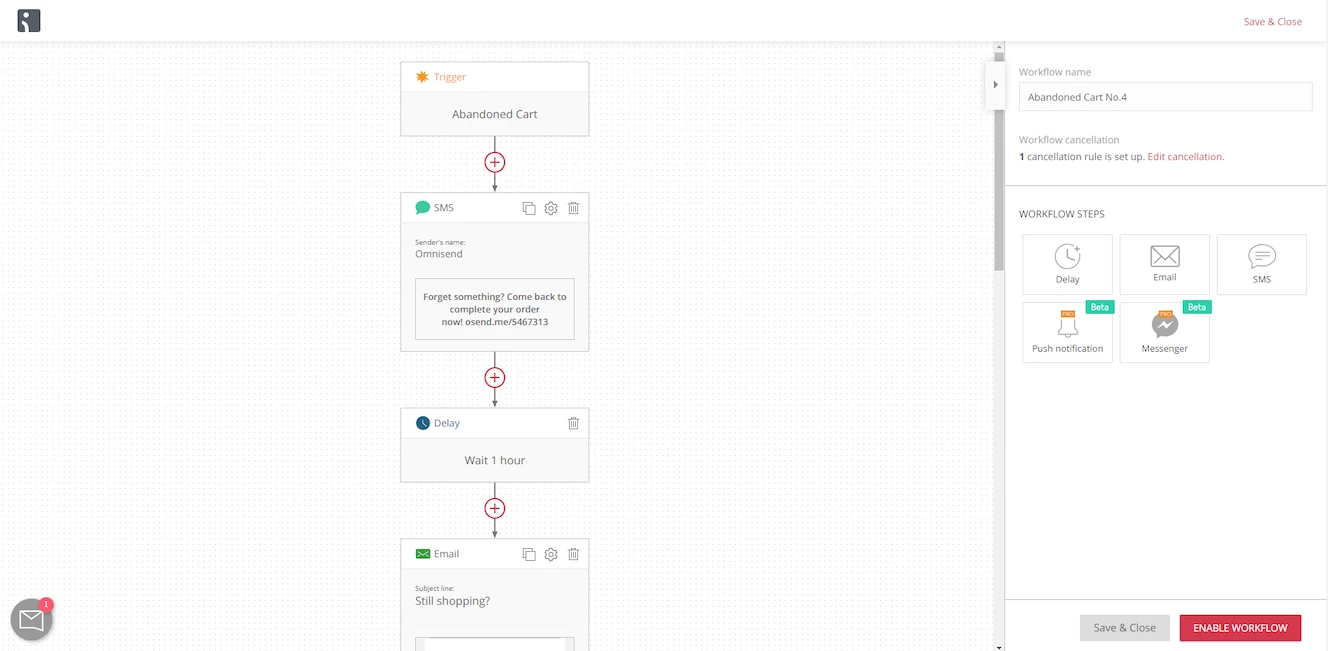
By focusing purely on e-commerce, Omnisend has built innovative email templates designed to reduce cart abandonment and drive repeat buyers. From ‘wheel of fortune’ offers to virtual scratch cards and birthday discounts, it’s evident that Omnisend’s built by a team intimately aware of what works in e-commerce.
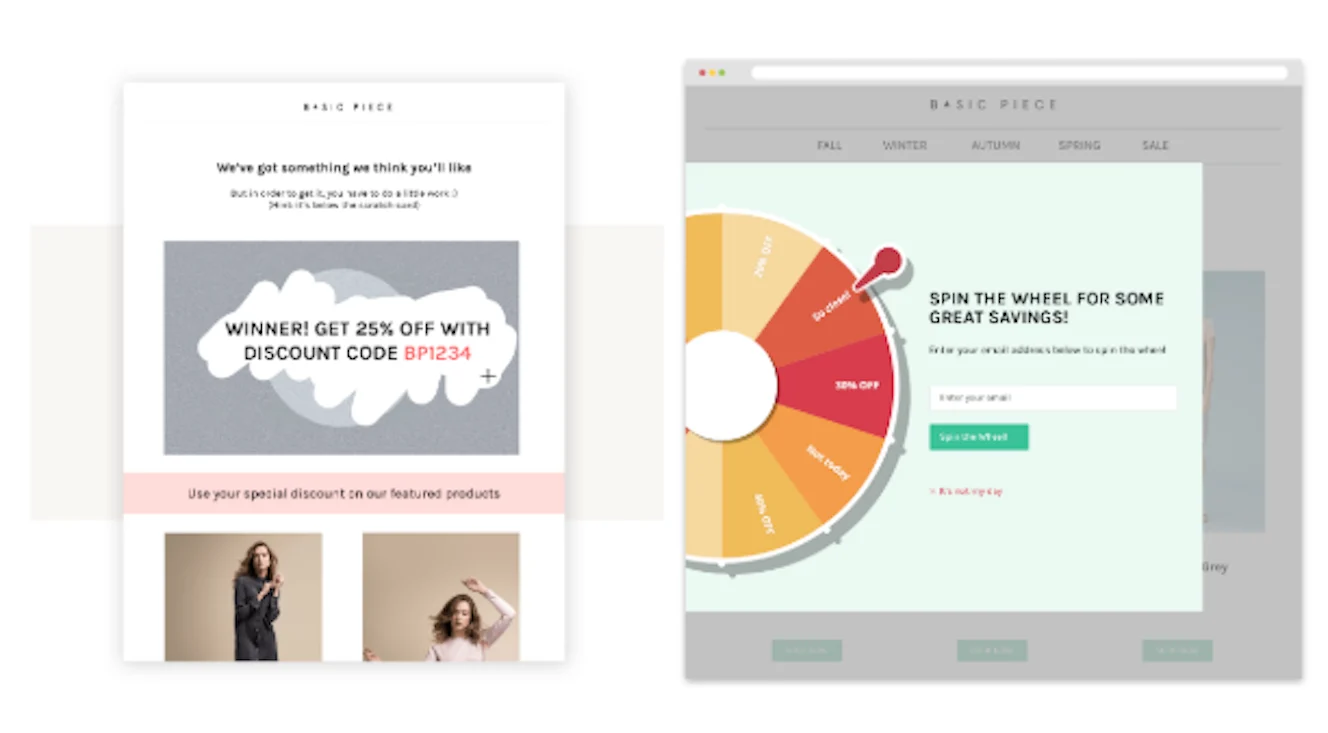
As you’d expect of an e-commerce email marketing tool, Omnisend hooks into most e-commerce platforms, including Magento, Shopify, and BigCommerce. Where Omnisend goes one step further is in integrating with review, loyalty and help desk platforms, such as Yotpo, Smile.io, and ReCharge.
This not only enables Omnisend to report on how your campaigns impact sales, but enables you to trigger email, SMS and social campaigns based around your customer behaviour to reduce cart abandonment, increase return buyers, drive more product reviews, and more.
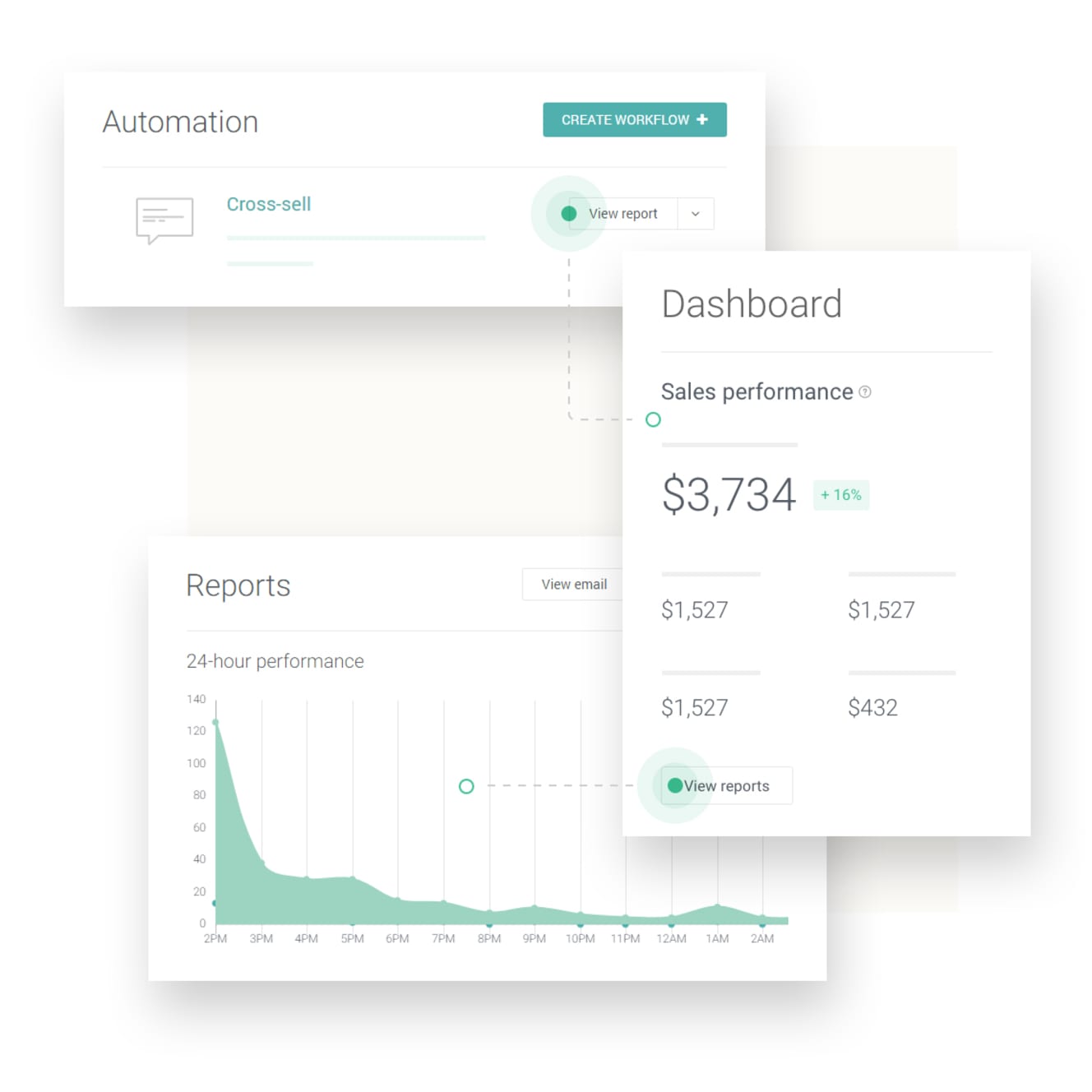
If you want the features that make Omnisend stand out, you’ll need a PRO account which starts at $199/month for up to 10,000 contacts. While not the cheapest, nor the easiest to use, Omnisend is a good option for e-commerce brands that want one multi-channel platform to rule them all.
What are Omnisend’s key features?
→ Visual email builder
→ Email, SMS and Push notifications
→ Transactional and marketing emails
→ Dynamic discount codes
→ e-commerce Segmentation
→ Retargeting
→ Surveys and Polls
→ Reporting
→ Popups and forms – wheel of fortune, scratch cards etc.
→ A/B Testing
UP she go's again ▲
#6 Autopilot
Gone are the days where email marketing is about sending bulk newsletters.
In today’s digital landscape, it’s essential for email marketing to be smart; sending the right messages to the right leads at the right time, automatically.
That’s why all of our top ten email marketing providers provide marketing automation. As the name would suggest, this is Autopilot’s forte. To boot, they have one of the best-designed canvases for building email automation sequences.
Anyone who has ever built an email automation sequence knows how quickly they can become confusing. Autopilot solves this in a rather quirky way, allowing you to annotate your automation sequences with emojis, stickers and explanations, making it easy for teams to collaborate on building sequences.
Yes, it can get messy – but I’d rather that and be able to understand what’s going on, than having beautiful automation sequences that take half an hour to interpret.
Another feature I love about Autopilot is its ability to trigger actions in your other tools inside Autopilot. This saves having to configure integrations using a tool like Zapier and makes your sequences much easier to understand.
Autopilot’s reporting is also excellent, though, I’ll go into this in more detail in our section on reporting and analytics below.
Starting at $49/month for 2,000 contacts, Autopilot is far from the cheapest option, particularly considering that Autopilot does not offer an in-built CRM. However, Autopilot is extremely intuitive and great for teams that need to collaborate on powerful email automation sequences. If we had to move from ActiveCampaign, this is likely where we’d go.
UP she go's again ▲
#7 HubSpot
HubSpot is world-class in offering businesses an all-in-one sales and marketing platform that includes a CRM, landing pages, email marketing, marketing automation, chat, forms, and everything in between.
While some argue that ‘trying to do everything’ is HubSpot’s downfall, it does enable them to do one thing exceptionally well; Reporting.
“Half the money I spend on advertising is wasted; the trouble is I don’t know which half.”
– John Wanamaker
Mr Wanamaker, obviously, didn’t use HubSpot.
By using HubSpot as the backbone of your marketing and sales, you can more easily attribute revenue back to the marketing campaign, newsletter, or blog post that influenced each sale. In this sense, HubSpot is more of a CRM that offers email marketing and automation, rather than vice versa.
A word of caution about HubSpot’s price-creep.
While much-loved, HubSpot is the second most likely response (behind Mailchimp) to “Which email marketing software are you leaving?” in our survey of 1,700+ email marketers. The reason is almost always the same; Price.
HubSpot position themselves as an affordable option for small businesses by offering (very limited) free versions of their products – but don’t be fooled by the HubSpot gateway-drug. Their platform becomes exponentially expensive as your list or feature requirements grow.
One business owner I spoke with started on a $50/month plan, and within a year needed a $2,000/month plan that had to be paid annually. The only difference was an extra 15,000 contacts and adding marketing automation, yet they jumped from seeing $50 leave the bank to $24,000.
This is where I feel conflicted about HubSpot.
On the one hand, you could get the same functionality for one-tenth of the price using ActiveCampaign, Benchmark, or half of the tools in this guide. On the other hand, if the value of knowing what influenced each sale is a problem worth paying a five-figure sum to solve, then HubSpot is a strong contender.
This is why we suggest that HubSpot is an ideal choice for B2B service companies, where the value of winning an extra one or two clients a year would easily cover the cost of HubSpot. This extends to larger, or more sophisticated, agencies that must provide clients with in-depth reports on their marketing funnel.
If you just need email marketing software, HubSpot is probably overkill. But if your search for email marketing software is part of a wider plan to raise to your marketing game and improve performance across your entire sales and marketing funnel, HubSpot is a strong contender – but don’t expect it to be cheap.
UP she go's again ▲
#8 ConvertKit
ConvertKit is a relatively simple email marketing tool used almost exclusively by bloggers and online course instructors to develop their personal brands.
Their platform has no bells or whistles. It doesn’t even have email templates, as ConvertKit encourages its users to send plain-text emails to increase engagement. As most of its users are individuals trying to build a personal brand this makes sense, but it does make ConvertKit a poor-fit for other use cases.
If you’re a creator that just needs a simple tool to serve your audience with regular content, there’s no better tool.
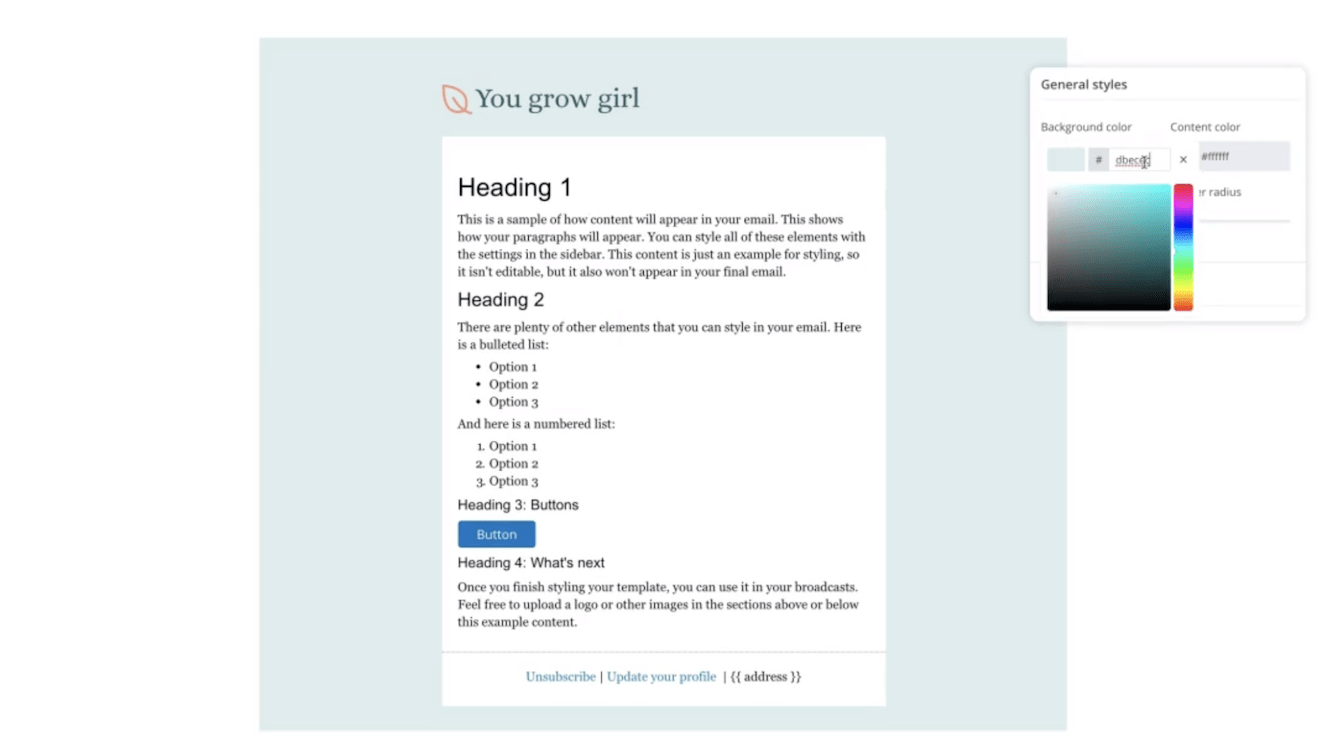
UP she go's again ▲
#9 MailerLite
At the opposite end of the price spectrum, we have MailerLite, which is among the best email marketing tools for value for money (it’s free for sending up to 12,000 emails/month to less than 1,000 contacts).
Unlike the other beginner email marketing tools out there, MailerLite is a universally good tool irrespective of industry. Whether you’re growing a small charity, a side-hustle, or are a freelancer starting out, MailerLite offers everything you need to send bulk email marketing campaigns.
If you’re a small business, I’d suggest that a tool like ActiveCampaign may be a better fit, as they offer an in-built CRM and more advanced marketing features for roughly the same price.
For beginners and personal projects, where you just need to send beautiful email campaigns to engage your audience, MailerLite is ideal.
UP she go's again ▲
#10 EmailOctopus
There’s long been a notion in email marketing that the most affordable way to send emails is using Amazon’s Simple Email Service (SES). Yet, the UI just isn’t built for marketing teams to create campaigns.
Many email marketing services have tried to bridge this gap – from Sendy to Moonmail, but they’ve often ended up either falling short on features or gravitating towards being more developer-centric.
EmailOctopus have nailed this balance.
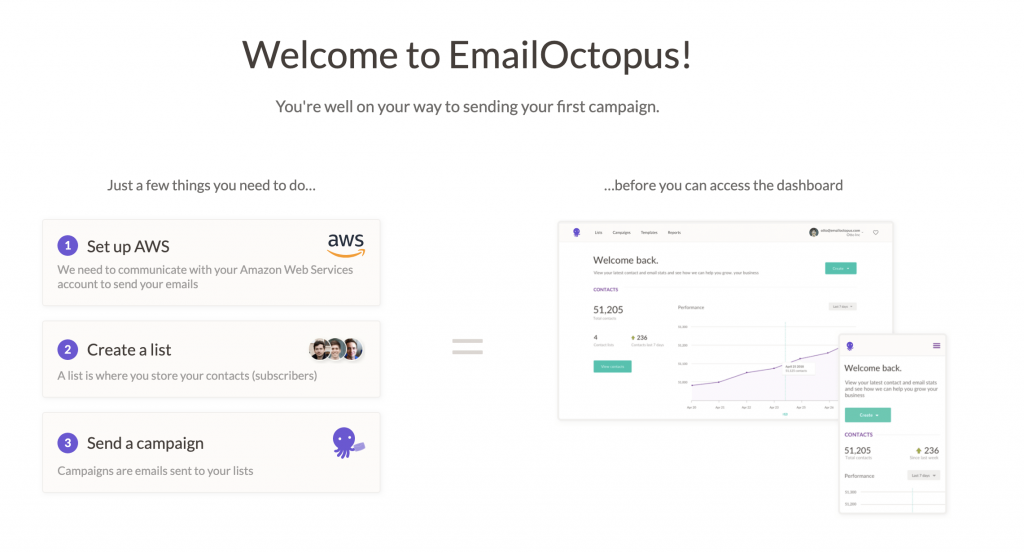
The benefits of Amazon SES, without the drawbacks
Amazon’s Simple Email Service (SES) is unbeatable from a cost perspective, and the deliverability is world-class. But it creates a huge bottleneck if used to send your marketing campaigns.
Every campaign, typo fix, and email sequence must be briefed as a development task, diverting scarce design and development resources to something that, frankly, is a flagrant waste of developer time.
EmailOctopus closes this gap. Built on the back of Amazon SES, EmailOctopus gives you the infrastructure benefits of AWS, while enabling you to build your email campaigns in a friendly UI.
The main downside of EmailOctopus is its simplicity. If you’re just sending email campaigns to a list that’s fine, but don’t expect the multi-touch attribution or visual automation builder that you’d find in a tool like ActiveCampaign.
EmailOctopus would be perfect for a small tech startup, where someone on the team is fluent in AWS and needs the flexibility and power of SES without the creation of the emails themselves needing to be coded.
Having covered the pros and cons of our top ten email marketing tools, we’ll now compare them head-to-head in nine areas that define a great email marketing tool.
UP she go's again ▲
What should you look for in email marketing software?
Email marketing software needs to grow your business by saving you time and converting your leads into customers, and those customers into repeat customers – on autopilot.
From surveying 1,700+ marketers in the process of changing their email marketing software, we discovered nine factors that separate the good from the great:
- 💰 Compare Cost
- 😌 Compare UX
- 📮 Compare Deliverability
- ✨ Compare Features
- 🤝 Compare CRMs
- 📊 Compare Reporting
- 🔌 Compare Integrations
- 🙋 Compare Support & Training
- 🔒Compare Security
Of course, every email marketing tool will tell you that they nail all nine, yet by analysing data and observing why marketers leave different email platforms, we’re able to capture a far more honest picture.
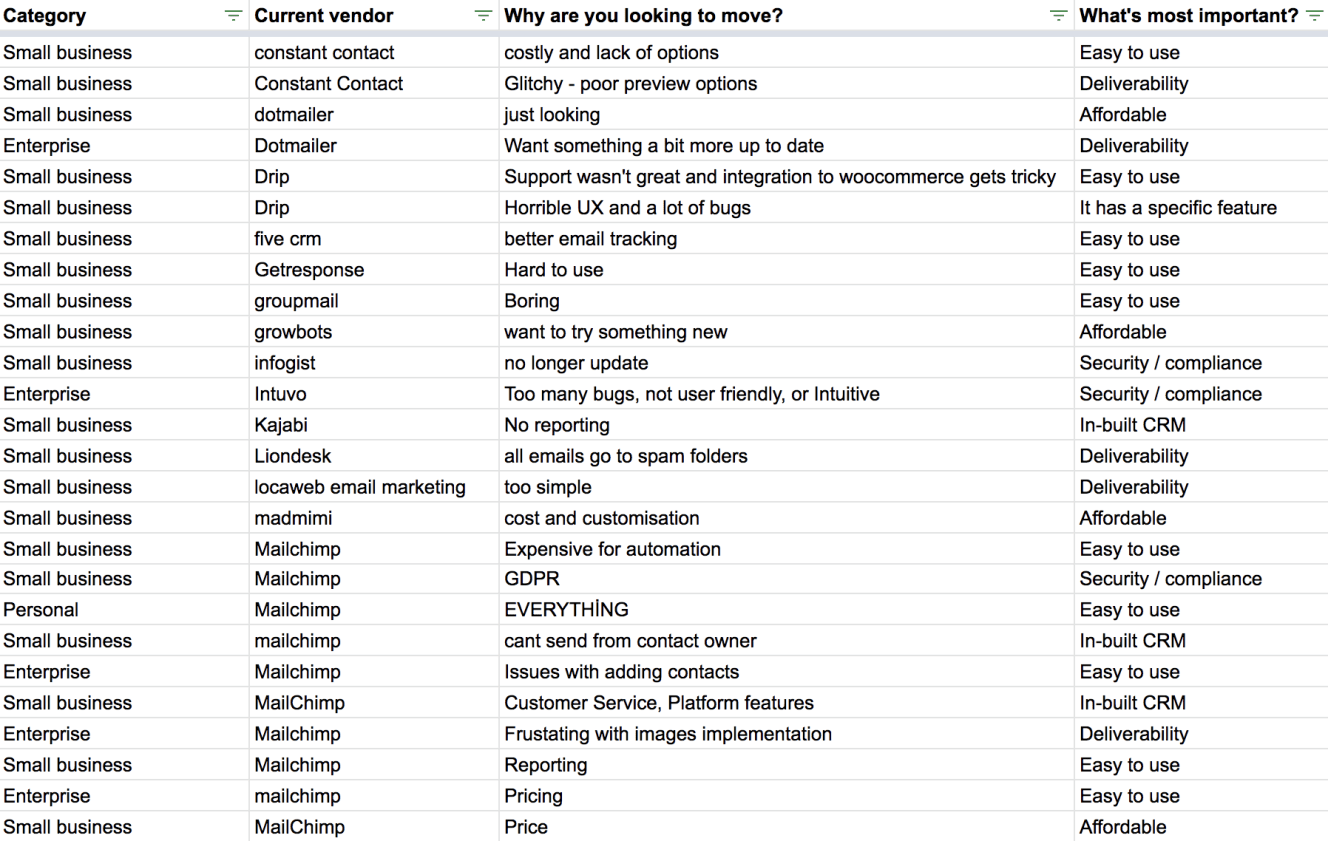
UP she go's again ▲
2. Best for ease of use
With some email marketing tools, it’s taken me three hours to make an email marketing template look acceptable on a mobile device. While all the email marketing tools featured offer visual email builders & easy-to-use interfaces, some are better than others.
While some are easy to use because they offer few bells and whistles, others strike a balance of being powerful while easy to use. The following three tools do the latter:
- ActiveCampaign
- Benchmark
- Mailerlite
Rather than explain how easy to use these three tools are, I’ll let screenshots of their email editors do the talking.
1. ActiveCampaign ♥
Apply for an ActiveCampaign demo account at our preferred certified agency in The Netherlands Mark-i
2. Benchmark
3. MailerLite
UP she go's again ▲
3. Best for deliverability
An email marketing tool is worthless if your emails end up in the spam folder. That’s why, as dull as it may be, deliverability is a crucial factor.
In order to get the best deliverability rates, there are a few things email marketing services need to do:
- Flag clients for review if they receive too many complaints or bounced emails
- Remove problematic clients
- Monitor blacklists
- Manage the reputation of their IP addresses.
All of the email marketing tools in our top ten do all of these. Regardless of which tool you choose, you can expect deliverability rates in the 98-99.9% range.
But if it’s particularly important to you to have the highest deliverability rates imaginable, there are two tools in particular that go above and beyond; ActiveCampaign and EmailOctopus.
ActiveCampaign’s impressive deliverability is the result of 17 years of optimisation and helping customers write better emails. They offer a very handy ‘spam check’ tool for predicting how likely an email is to land in the inbox, and if a score is too low it suggests what changes you should make.
EmailOctopus’ high deliverability is a result of it being based on Amazon’s SES infrastructure – which has very high deliverability rates.
If you want to take deliverability into your own hands, you may wish to buy a dedicated IP for sending emails. This is a feature offered by both companies.
Apply for an ActiveCampaign demo account at our preferred certified agency in The Netherlands
UP she go's again ▲
4. Best for email marketing features
If you try any of the email marketing tools in this article, you’ll find that they all offer the standard features that you’d expect from an email marketing tool, such as visual email campaign builders, pre-designed email templates, and autoresponders.
Only a handful go above and beyond with additional email marketing features designed to save you time and get better results. Here are our top three email marketing tools that go above and beyond with features.
- ActiveCampaign
- HubSpot
- Omnisend
1. ActiveCampaign ♥
Automation A/B Testing – While most email marketing tools allow you to split-test subject lines, send times, and content, ActiveCampaign is one of the only services that allow you to split-test automation sequences.
This means you can split test radical changes like sending ten emails to new leads versus only four, to see which sequence has the highest conversion rate.
Conditional content – ActiveCampaign is one of the only email marketing services that allow you to include conditional ‘IF X is true, show Y’ content blocks inside email campaigns.
We use this for localising pricing (i.e. show $ in the United States, £ in the UK, and € in Europe), and displaying different recommended articles to different customers based on their plan or engagement level.
Global variables – We have over 200 automated emails setup in our ActiveCampaign account. What happens if, for example, I want to change something in my email signature? Or update the pricing of one of our plans?
With other email marketing tools, you’d have to go into each email and manually update the changes one-by-one. This is where global variables are a big time saver. Instead of inserting the actual price in an email campaign you can enter %price% and it will replace all variables with the actual price when the email is sent out.
Downloadable automation recipes – ActiveCampaign is one of the only email marketing tools to offer a range of automation ‘recipes’. Instead of spending days building an elaborate sequence of upsell emails, you can just use one they’ve already made, and then adjust the content so that fits your brand.
In addition to saving a lot of time, these recipes are a great source of inspiration.
Apply for an ActiveCampaign demo account at our preferred certified agency in The Netherlands
2. HubSpot
Smart Content – Similar to the conditional content feature offered by ActiveCampaign, Smart Content allows you to hide and display blocks of content in your email campaigns based on where a contact is in your buying cycle, or which lists they are in.
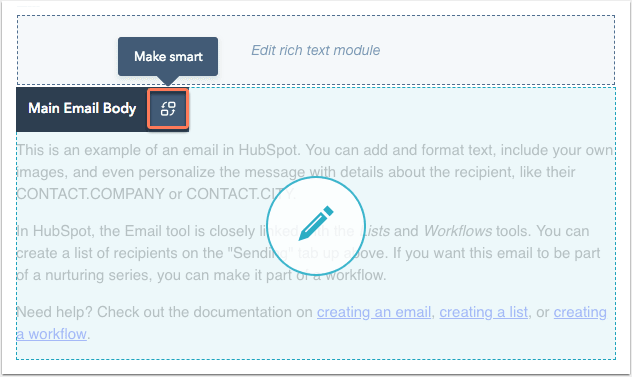
Subject line emojis – Using emojis in subject lines have been found to increase open rates by as much as 45%. While you can technically put emojis in the subject line using almost any email marketing tool, HubSpot makes it a bit easier by having an emoji button next to the subject line box.
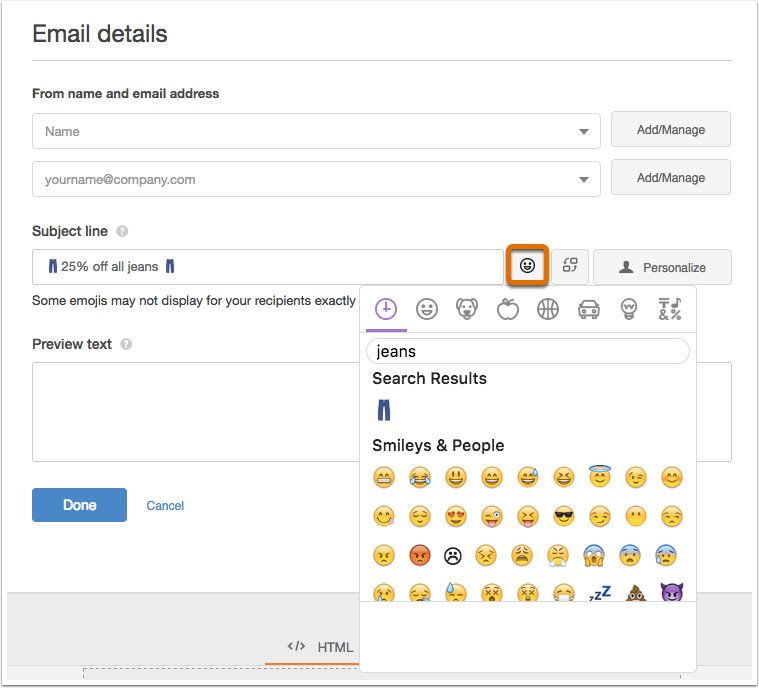
Progressive Profiling – Let’s say a lead visits your website on day one and exchanges her name and email address to download a whitepaper. The next day, they come back to your website to learn more.
Instead of showing the same form asking for their name and email address, HubSpot allows you to identify this lead and show a different offer, or ask a different set of questions to learn more about them over time. This is called Progressive profiling – and it allows you to send more personalised email campaigns as you gather more information on your leads.
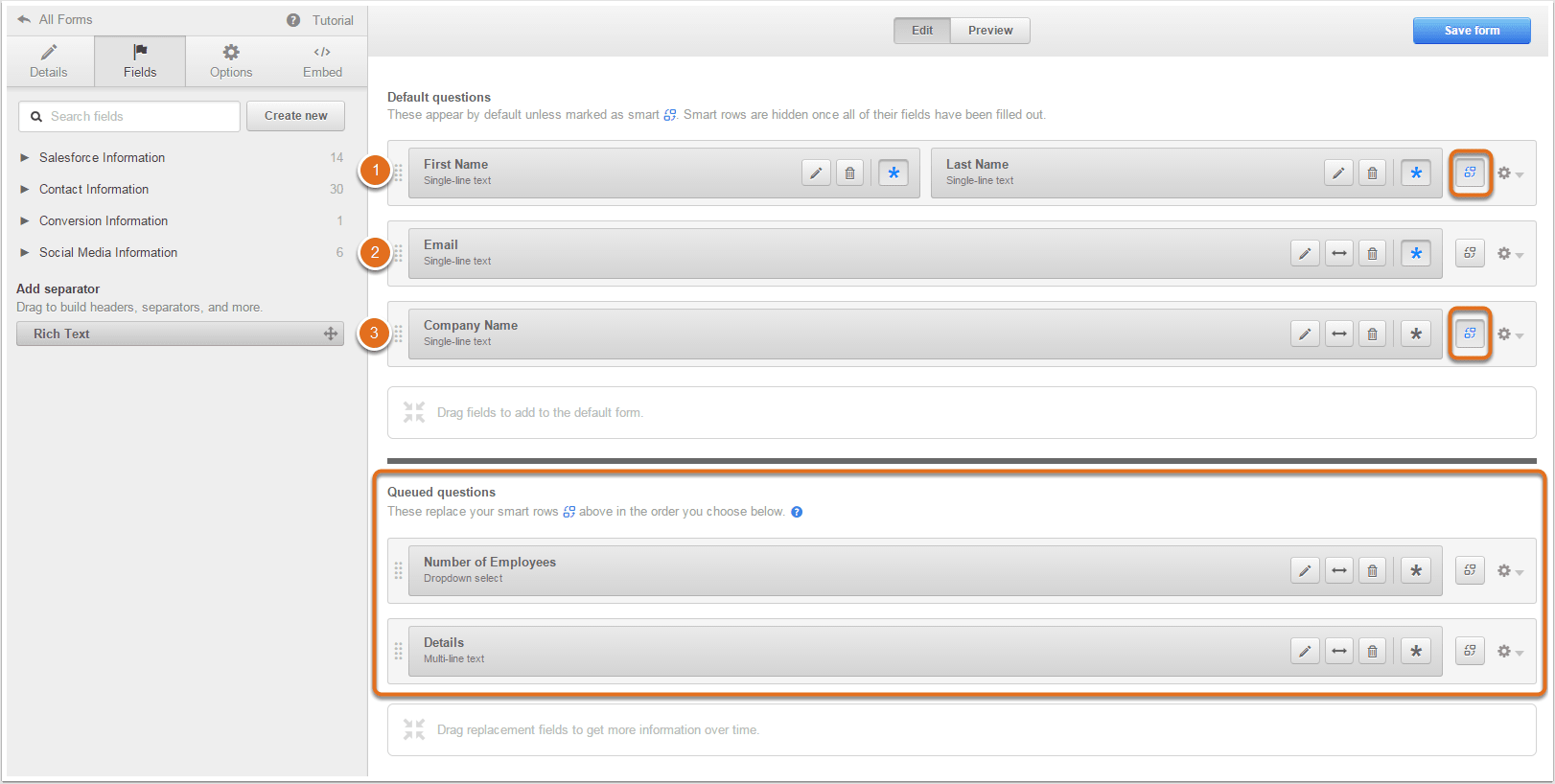
3. Omnisend
Omnisend offers an impressive range of e-commerce email marketing features.
Campaign Booster – Omnisend has a ‘campaign booster’ feature that automatically resends campaigns to subscribers who haven’t opened an email campaign (a quick-win that Omnisend state boosts email sales by up to 30%).
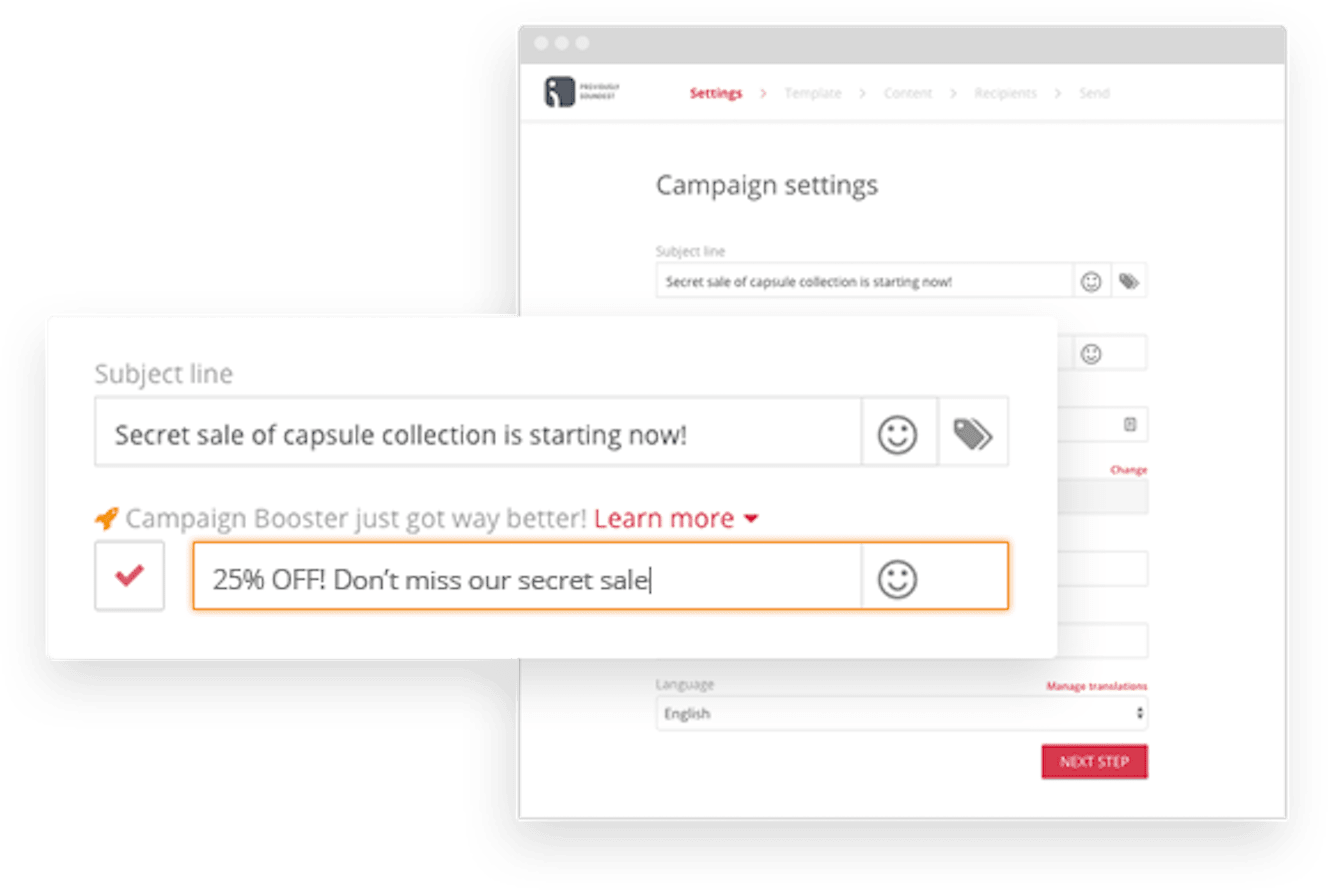
Product Picker – In addition to being able to drag and drop products from your store directly into email campaigns (a huge time saver), Omnisend also has a handful of CTR boosting email templates, such as scratch cards and gift boxes.
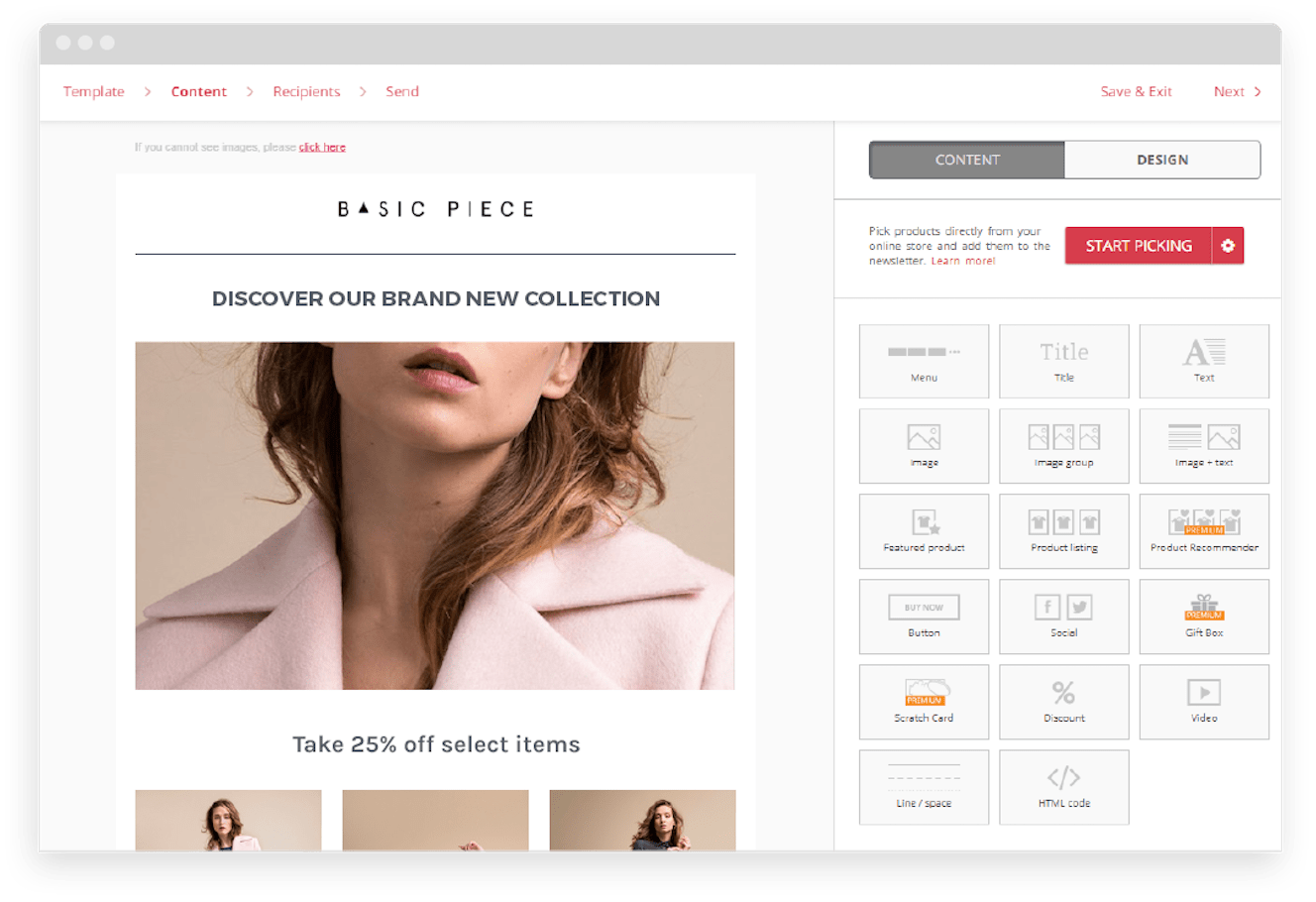
Discount codes – One final feature that’s a nice touch for e-commerce users is Omnisend’s discount code generator, which connects to your e-commerce store and automatically generates unique discount codes to incentivise customers to buy again from you.
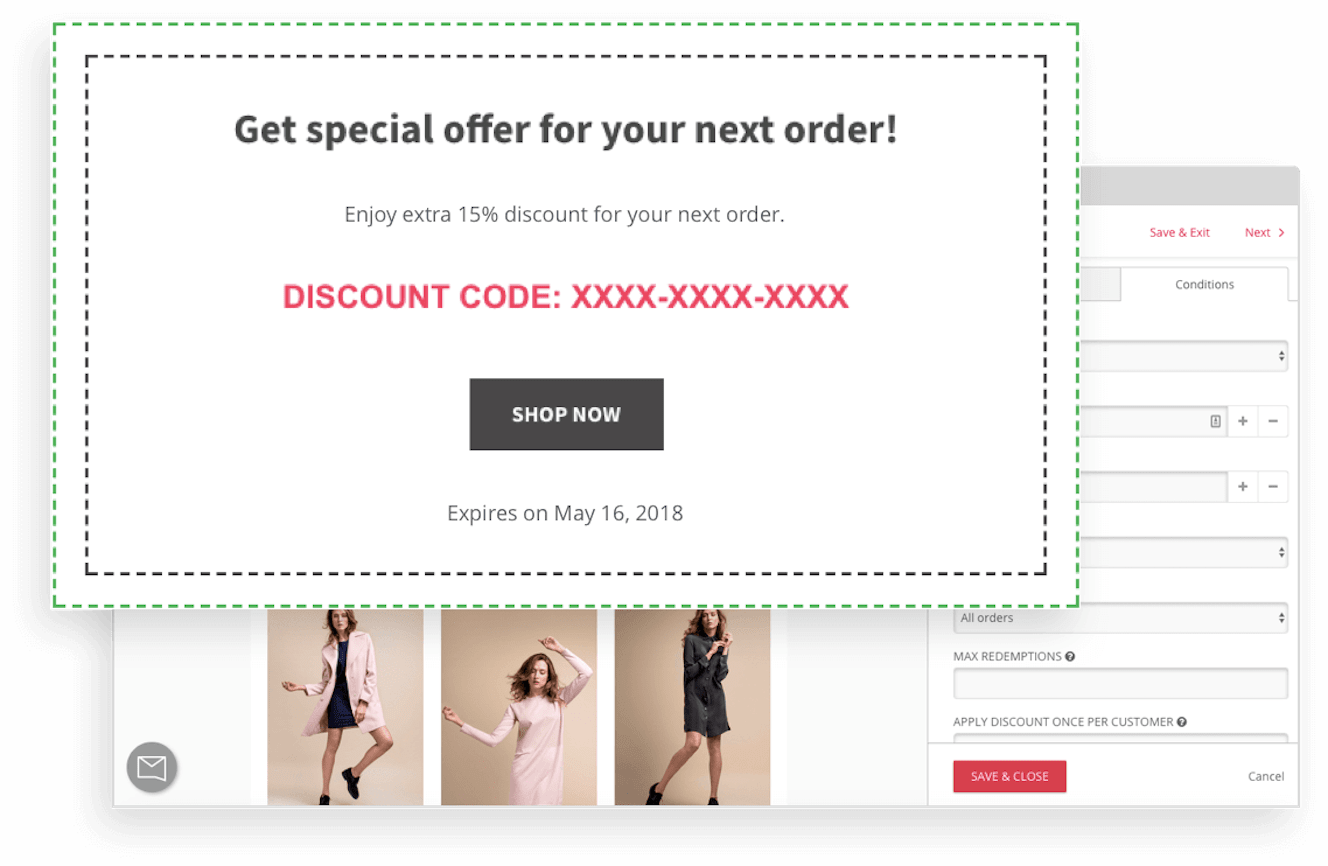
UP she go's again ▲
5. Best for CRM & marketing automation features
Unless you’re a large enterprise it probably makes sense to use an email marketing tool that also has an in-built CRM (customer relationship management) and marketing automation functionality.
The reason for this is that email marketing works best when emails are triggered to the right people at the right time – and the data required to enable this is often stored in a CRM system. While you can make this work with a separate CRM, integrating the two is an extra step that could be avoided.
This requirement technically rules out all but two of our top ten, with HubSpot and ActiveCampaign remaining. We have also included Autopilot here, which despite not having a CRM has exceptional native integrations with the most popular CRMs and has the best marketing automation features we’ve seen.
#1 HubSpot ♥
HubSpot is the undisputed leader in this category. As an all-in-one sales & marketing platform, they offer a full CRM system, as well as in-built tools for blogging, social media management, landing page creation, and… well, you name it they probably offer it.
Their CRM system is extremely powerful, yet straightforward to use. You can view deals in a pipeline format (as shown above) or as one long list in a table.
Because HubSpot contains so much data on each of your leads, you can use their marketing automation platform to build email sequences that use CRM data to trigger emails to contacts based on their behaviour.
Frankly, HubSpot’s email marketing automation builder is not the best I’ve seen – but in tandem with their CRM, it’s a powerful feature.
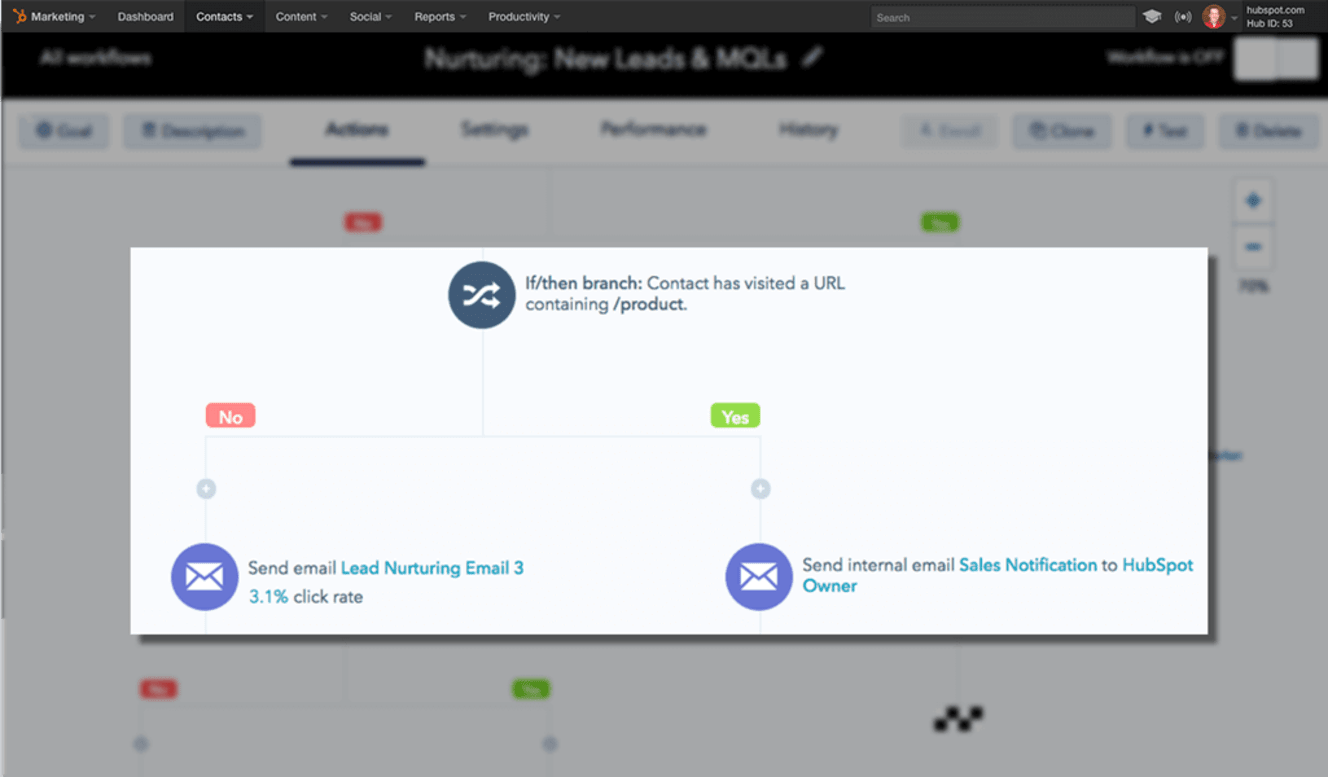
#2 ActiveCampaign
As you can see below, ActiveCampaign’s CRM is very similar to HubSpot’s in design and functionality.
Similarly to HubSpot, ActiveCampaign tracks your lead’s activity on your website (or app) and can automatically move leads into different stages of your pipeline based on which pages they’ve visited, whether they’ve bought a product, clicked on an email etc.
You can also deep-dive into any lead or customer’s profile to see a full history of every interaction that person has had with your company since they first gave you their email address.
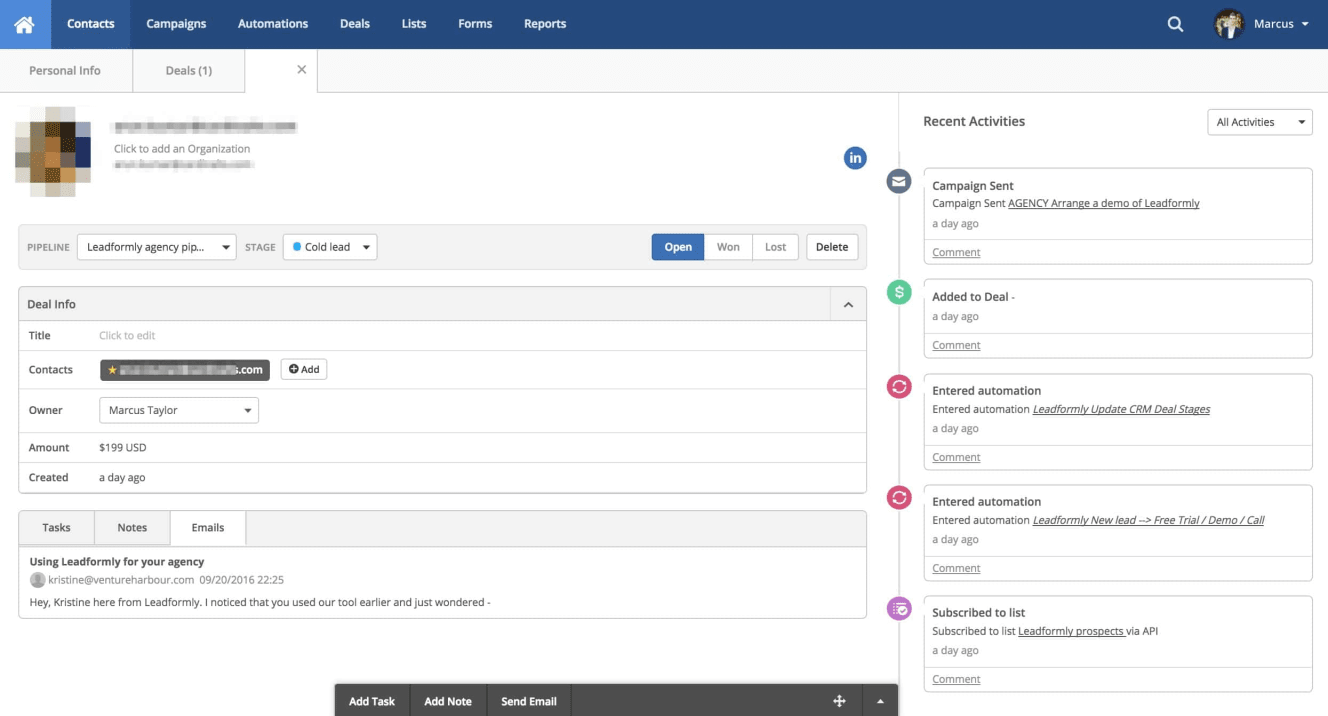
Where ActiveCampaign shines is with its marketing automation builder. We’ve already touched on this in previous sections of this article, so I won’t go into much more detail here.
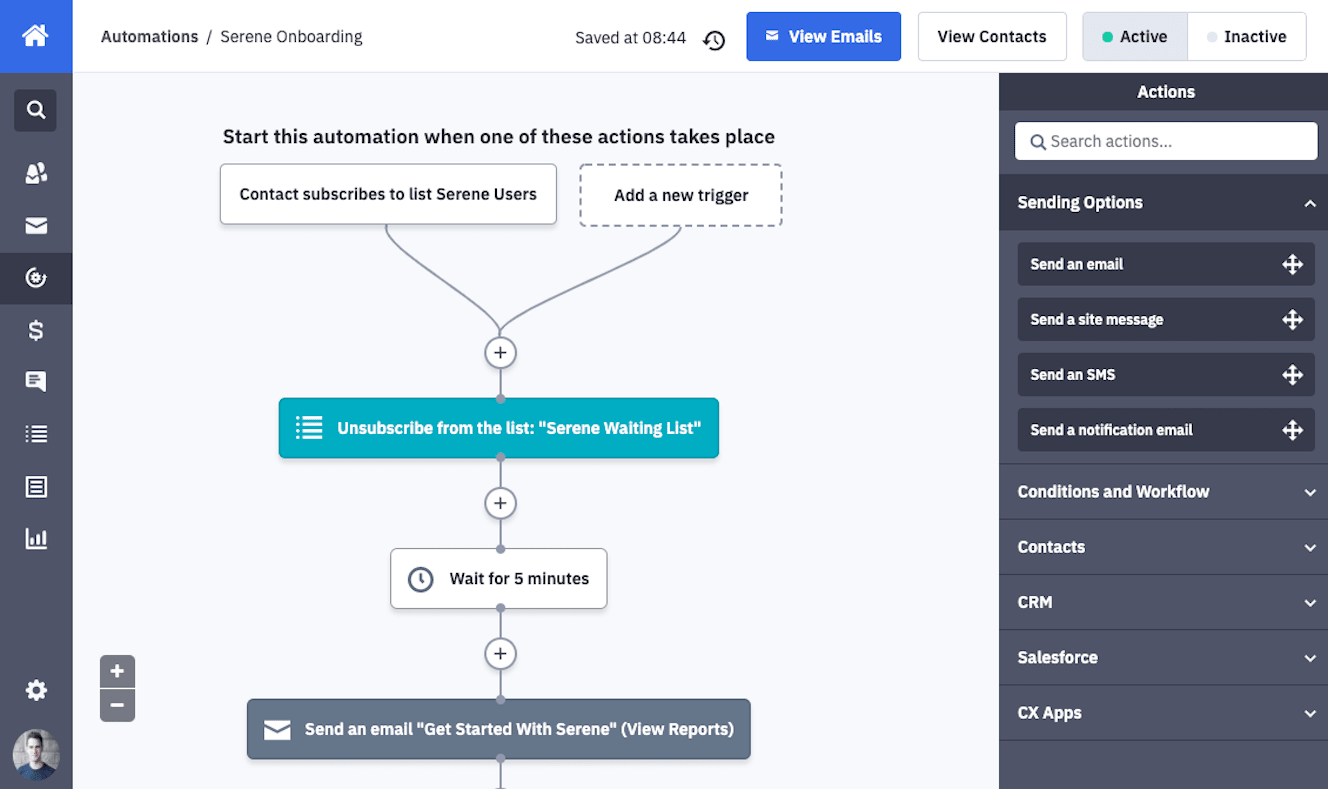
Apply for an ActiveCampaign demo account at our preferred certified agency in The Netherlands
3. Autopilot
While Autopilot doesn’t have an in-built CRM, its marketing automation platform is second to none, and it integrates natively with a handful of the most popular CRMs (including HubSpot CRM, Pipedrive, and Salesforce).
If you use a CRM that’s not listed above, Autopilot also offers a Zapier integration, as well as a native integration with Segment, allowing you to keep your CRM in sync, and trigger your automation sequences from updates in your CRM.
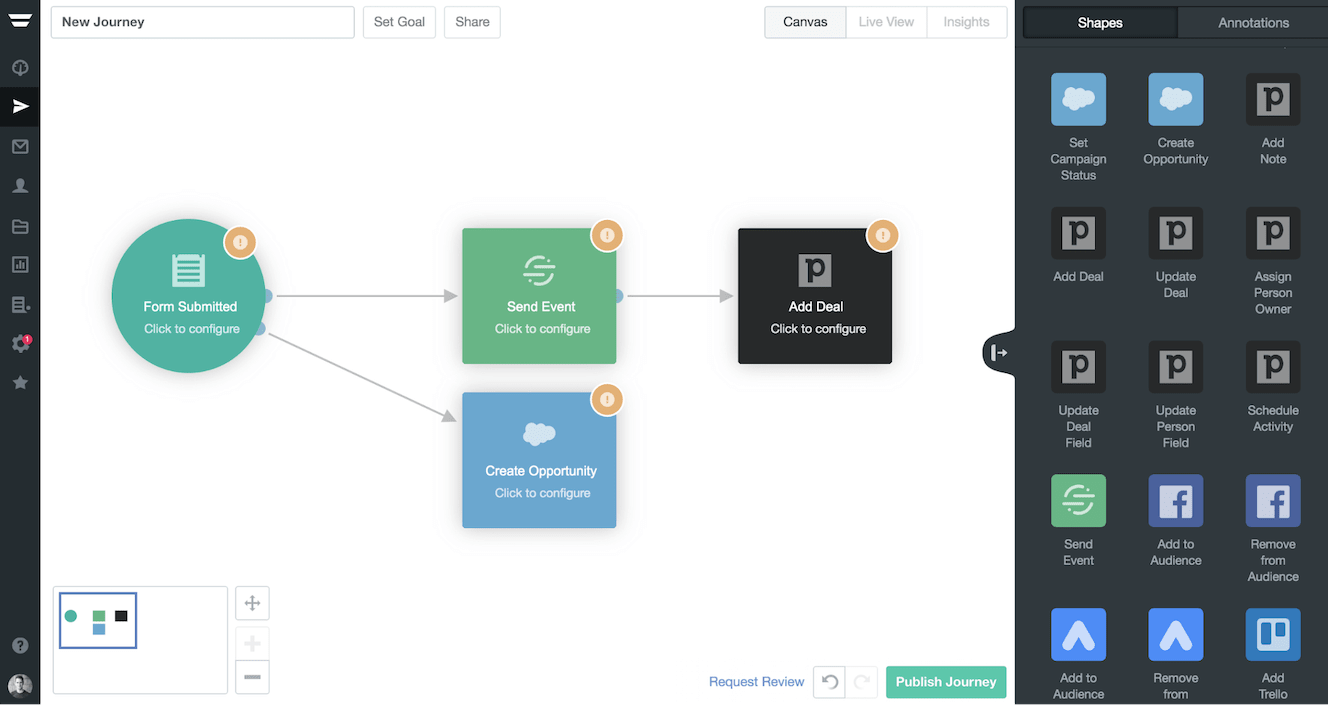
UP she go's again ▲
6. Best for reporting & analytics
Most email marketing tools offer very little when it comes to reporting functionality, to the point that understanding what emails are generating a positive return on investment can be a surprisingly difficult question to answer.
In our review of the top ten email marketing tools, we were most impressed by the email analytics and reporting offered by these three companies.
#1 HubSpot ♥
HubSpot has an unfair advantage.
As an all-in-one marketing platform, it should come as no surprise that they offer a huge variety of reports, answering every marketing question imaginable. To give credit where it’s due, these aren’t vanity metrics either; HubSpot does a very good job at answering the difficult questions that actually provide actionable insights.
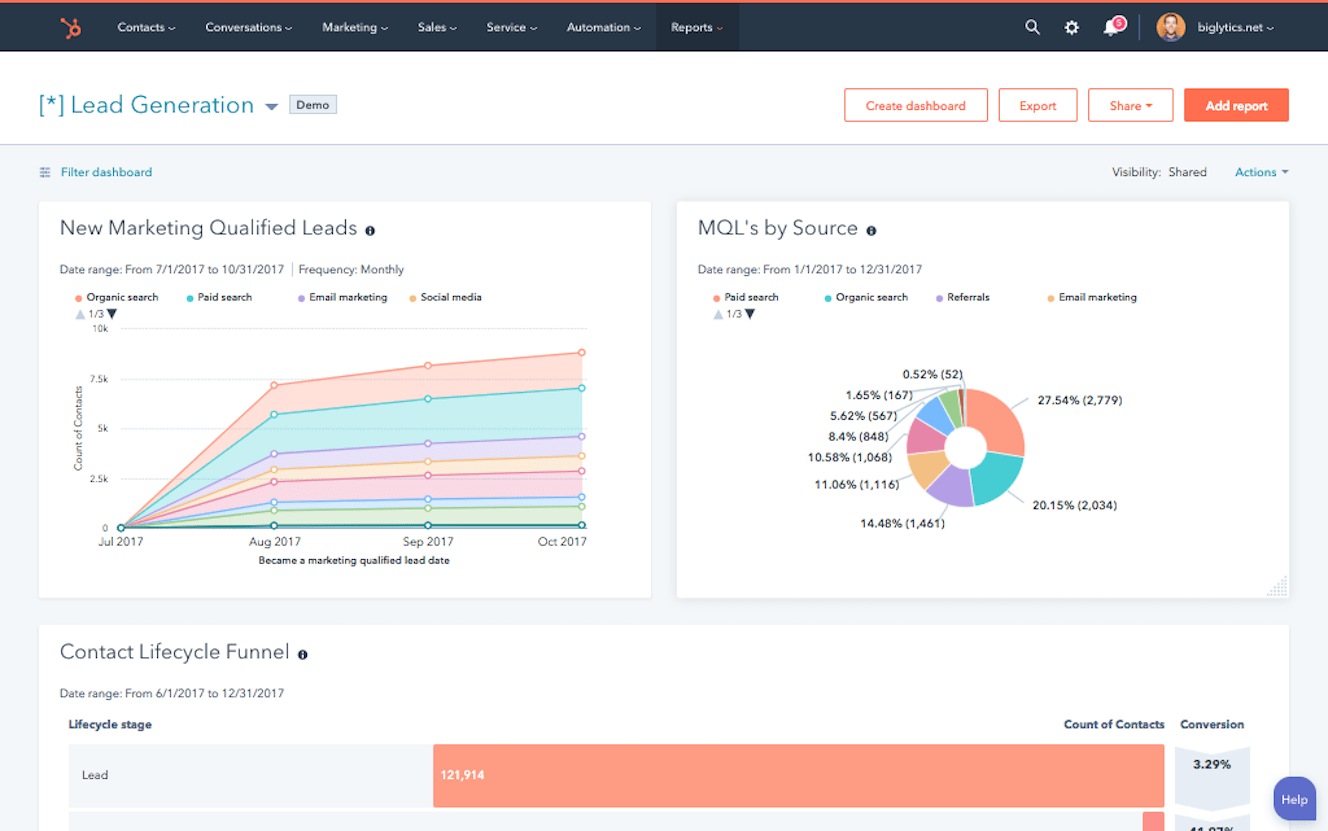
Of course, this kind of reporting comes at a cost (HubSpot’s not cheap, as we’ve already covered) but you do get a lot more insight compared to just knowing how many people opened or unsubscribed from your email campaigns.
Their campaign reports are easy to digest and surprisingly insightful. Interestingly, HubSpot is one of the only email marketing tools to report on the time people spend reading an email.
2. Autopilot
What I particularly like about Autopilot is that you can set the goal of each automation journey and view reports around whether that automation journey is hitting its goal.
For example, I can set a goal that my lead nurturing journey should convert 20% of contacts that enter it to buy my product and then produce a report like this.
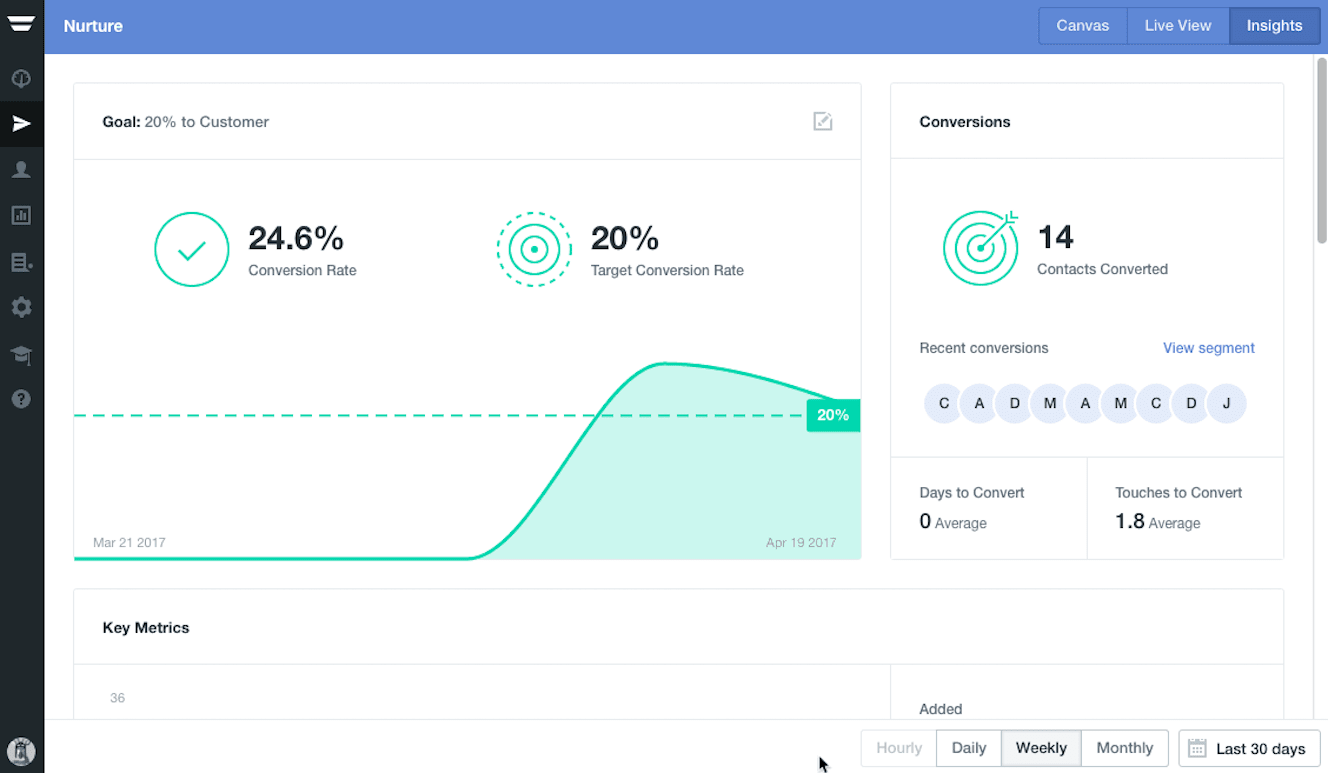
Beyond this, Autopilot’s reporting is fairly basic, with the usual reporting on campaign performance and contact list insights.
3. ActiveCampaign
In some ways, I’m reluctant to feature ActiveCampaign in this section, as their reporting is definitely not their strong point. But, credit where it’s due, it’s come along way in the last year and it’s still much better than many other tools for the same reason as Autopilot above – it focuses on goal tracking.
The big difference is that, while Autopilot has managed to make this look beautiful, ActiveCampaign’s visualisation of these reports is a bit convoluted.
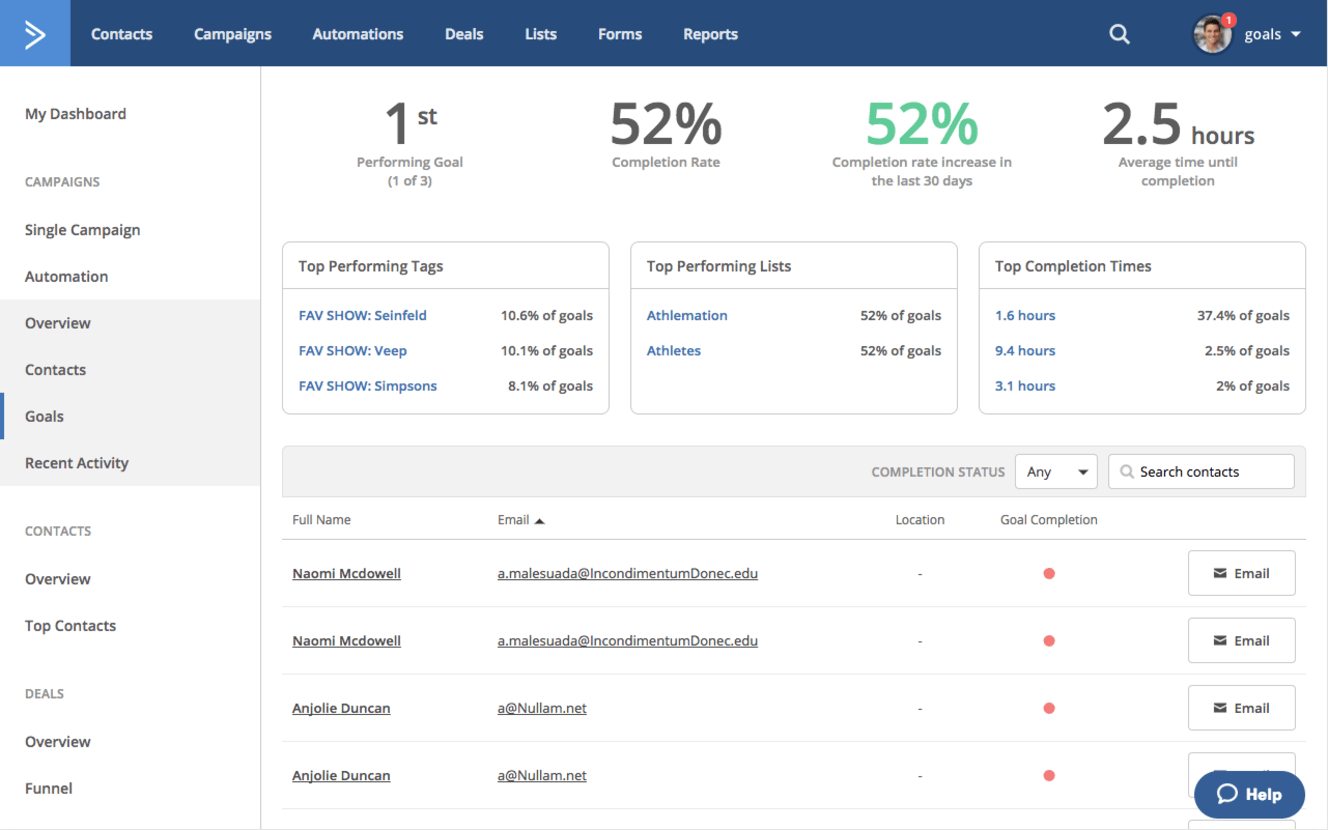
ActiveCampaign’s reporting can answer almost any question you throw at it – but you need to be quite mindful of knowing what that question is.
Where HubSpot and Autopilot serve up high-quality answers on a platter, ActiveCampaign’s approach is more akin to vomiting data across 20 or so pages, making it difficult to decipher value from vanity metrics.
Apply for an ActiveCampaign demo account at our preferred certified agency in The Netherlands
UP she go's again ▲
7. Best for integrations
These days, most email marketing tools integrate with Zapier (a third-party tool that allows you to then send data to over 1,000+ third-party apps & tools) rather than building their own smorgasbord of integrations. There are some exceptions, such as Autopilot, which has an enormous variety of native integrations.
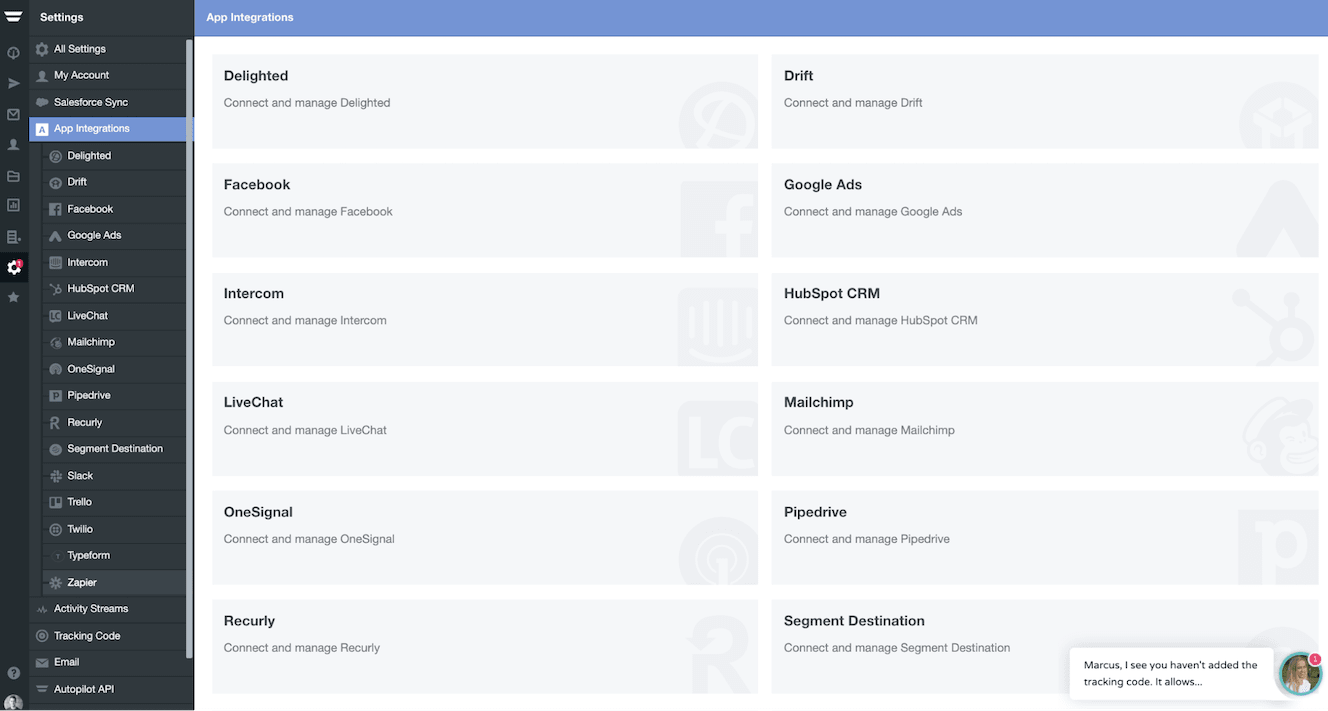
The best email marketing tools for integrating with third-party tools are:
- ActiveCampaign ♥
- Autopilot
- HubSpot
When it comes to Zapier integrations, not all of them are created equal. Every ‘zap’ (integration) has two parts: A trigger and an action. For example, let’s say you want to build an integration so that every time someone subscribes to your mailing list (the trigger), they’re automatically added to a Google Spreadsheet (the action), this can be built in minutes using Zapier.
Broadly speaking, the more triggers and actions an email marketing tool provides, the easier it is to automate tasks. Below is a list of the top ten email marketing tools, ranked from highest number of triggers, actions and searches to lowest.
| Type | Zapier Triggers | Zapier Actions & Searches | |
|---|---|---|---|
| HubSpot | Free | 13 | 17 |
| ActiveCampaign | Free | 13 | 11 |
| Drip | Free | 16 | 6 |
| ConvertKit | Free | 7 | 5 |
| Autopilot | Free | 4 | 4 |
| MailerLite | Free | 2 | 2 |
| Benchmark | Free | 2 | 1 |
| Sendinblue | Free | 2 | 1 |
| Omnisend | Free | 0 | 2 |
| EmailOctopus | Free | 0 | 3 |
UP she go's again ▲
9. Best for security & compliance
If you capture sensitive personal data or, due to your industry or size, require an email marketing provider that has particular security and privacy compliance certifications, we’d suggest either:
- ActiveCampaign ♥
- HubSpot
- MailerLite
As you’d expect, these larger and older email marketing providers tend to be the best option when it comes to security and compliance. All three of the services above provide extensive documentation on their websites about their security and compliance measures.
For a more detailed comparison of which security/compliance certifications and features these three email marketing tools offer, we’ve created the table below.
| ActiveCampaign | HubSpot | MailerLite | |
|---|---|---|---|
| ISO 27018 (cloud privacy) | Yes | No | No |
| ISO 27001 (information security) | Yes | Yes | Yes |
| ISO 27017 (cloud security) | Yes | No | No |
| EU-US Privacy Shield | Yes | Yes | Yes |
| GDPR Compliant | Yes | Yes | Yes |
| CAN-SPAM Compliant | Yes | Yes | Yes |
| HIPAA Compliant | Yes (enterprise account only) | No | No |
| TLS encryption | Yes | Yes | Yes |
| Segmented accounts | Yes | Yes | No |
Apply for an ActiveCampaign demo account at our preferred certified agency in The Netherlands
Credits to: ventureharbour.com "Grow, don't guess"
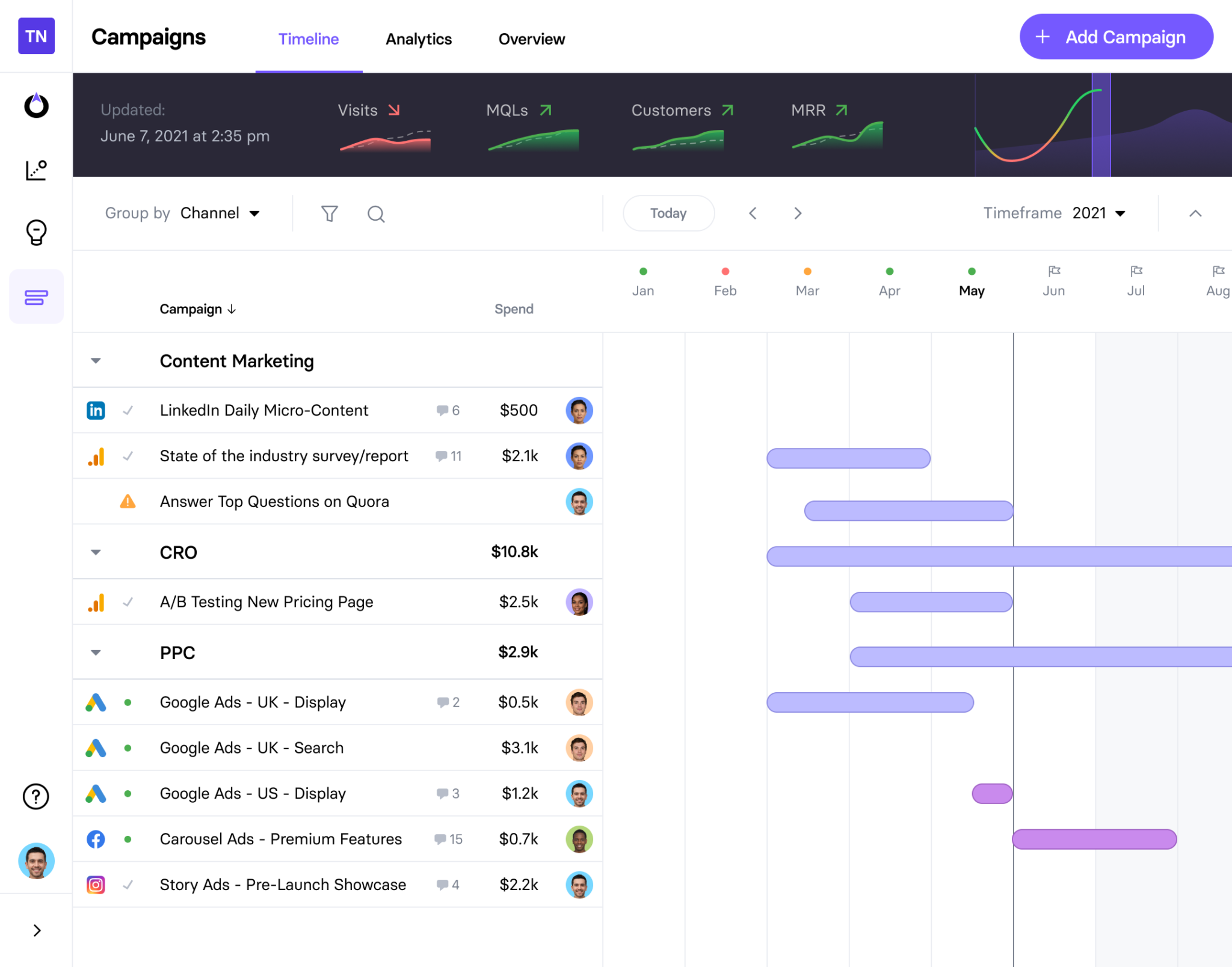
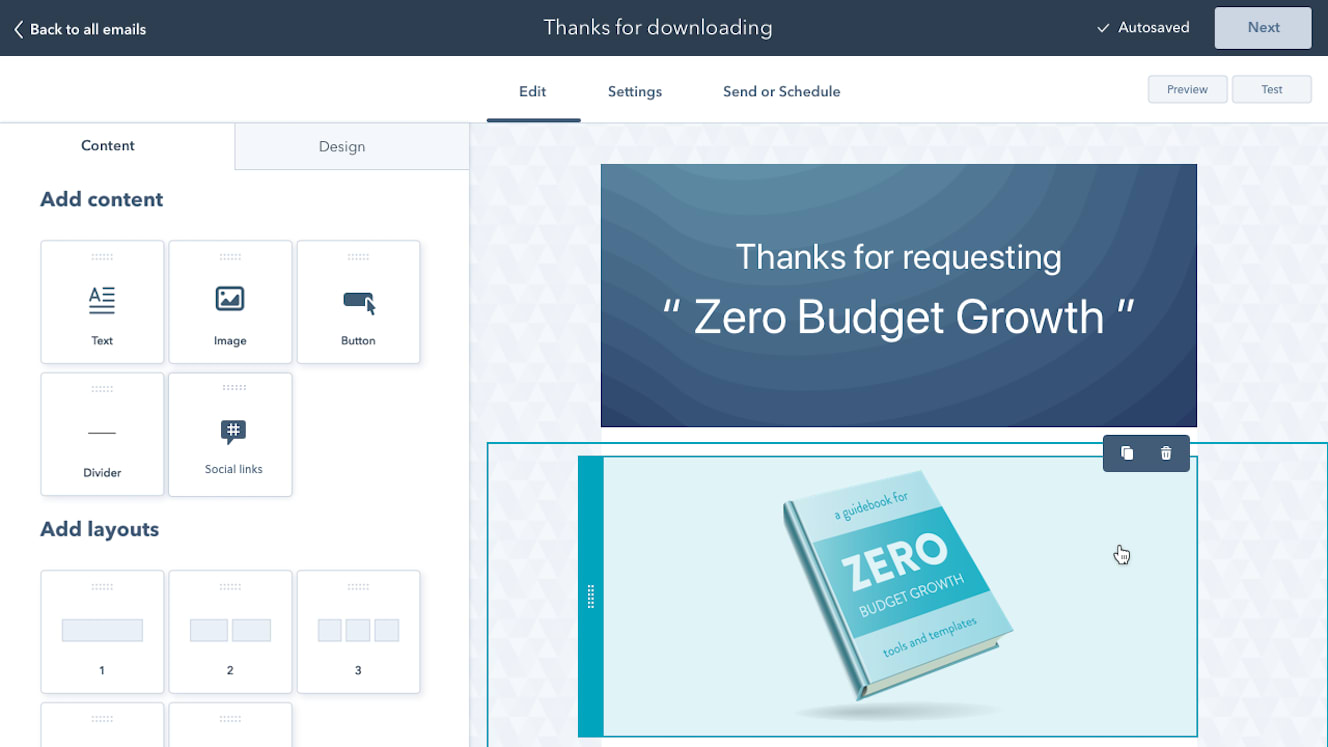
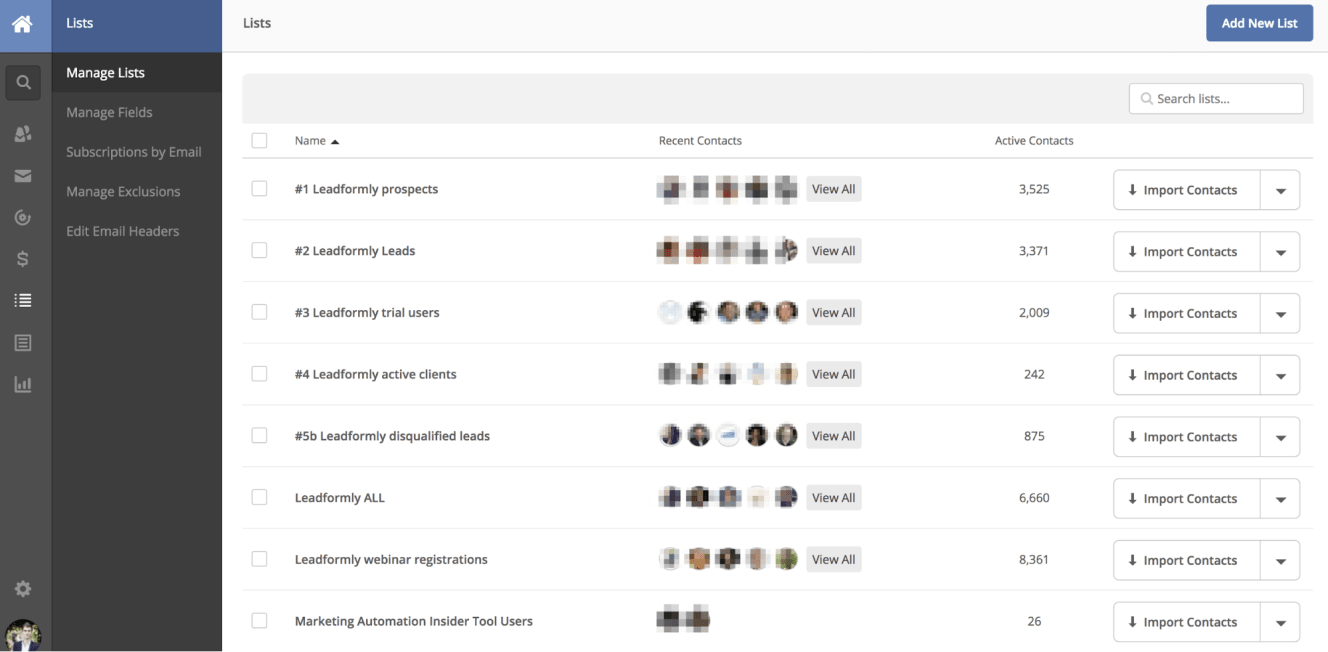
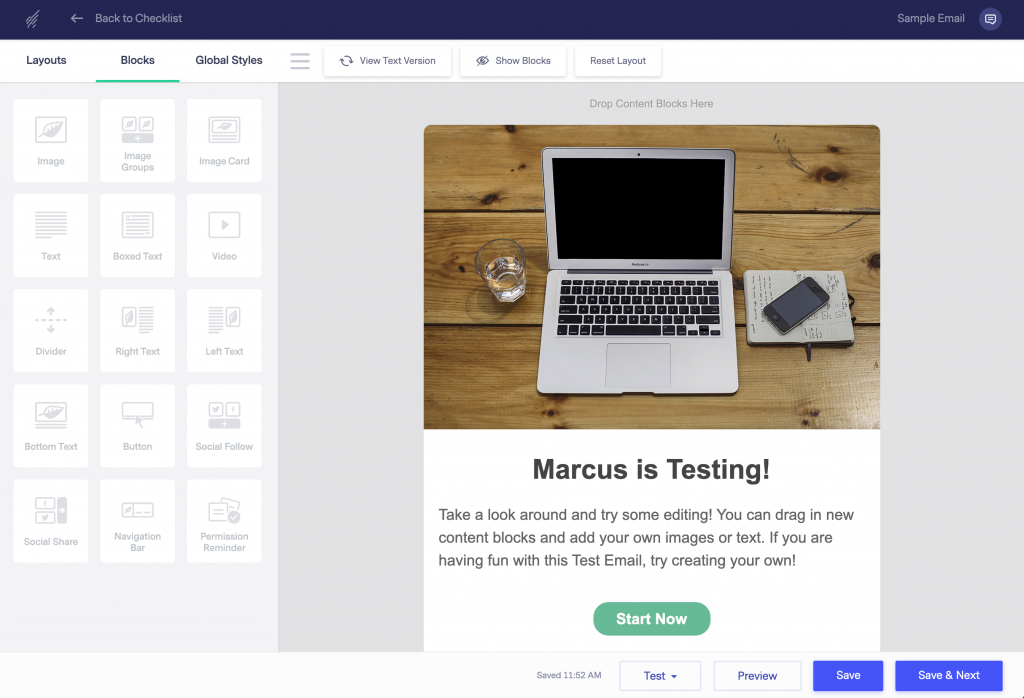
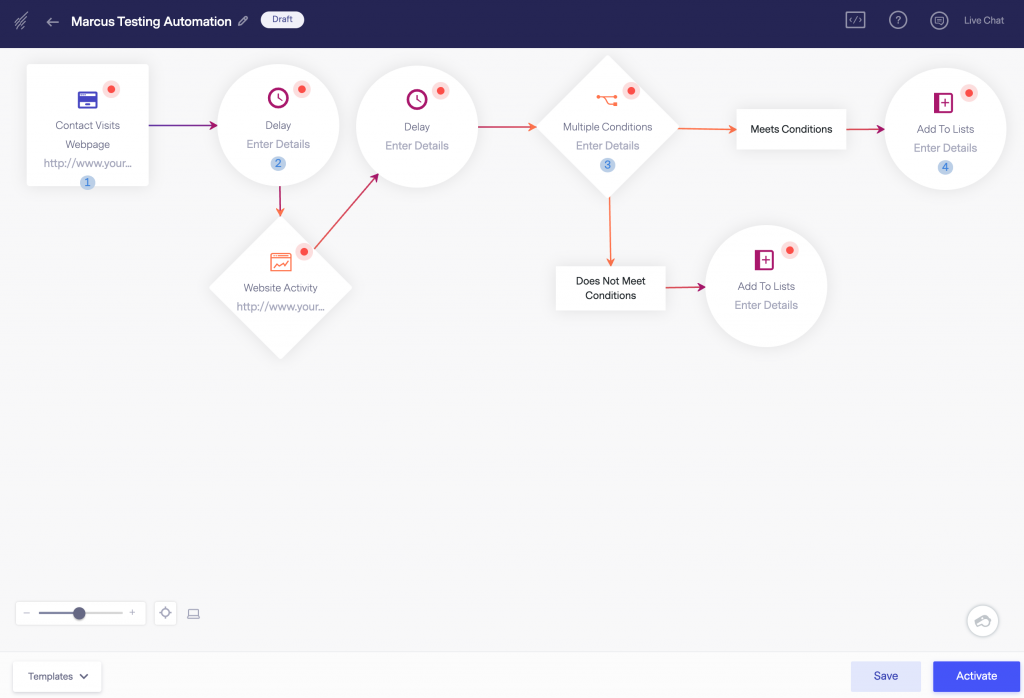
Opmerkingen
0 opmerkingen
Artikel is gesloten voor opmerkingen.